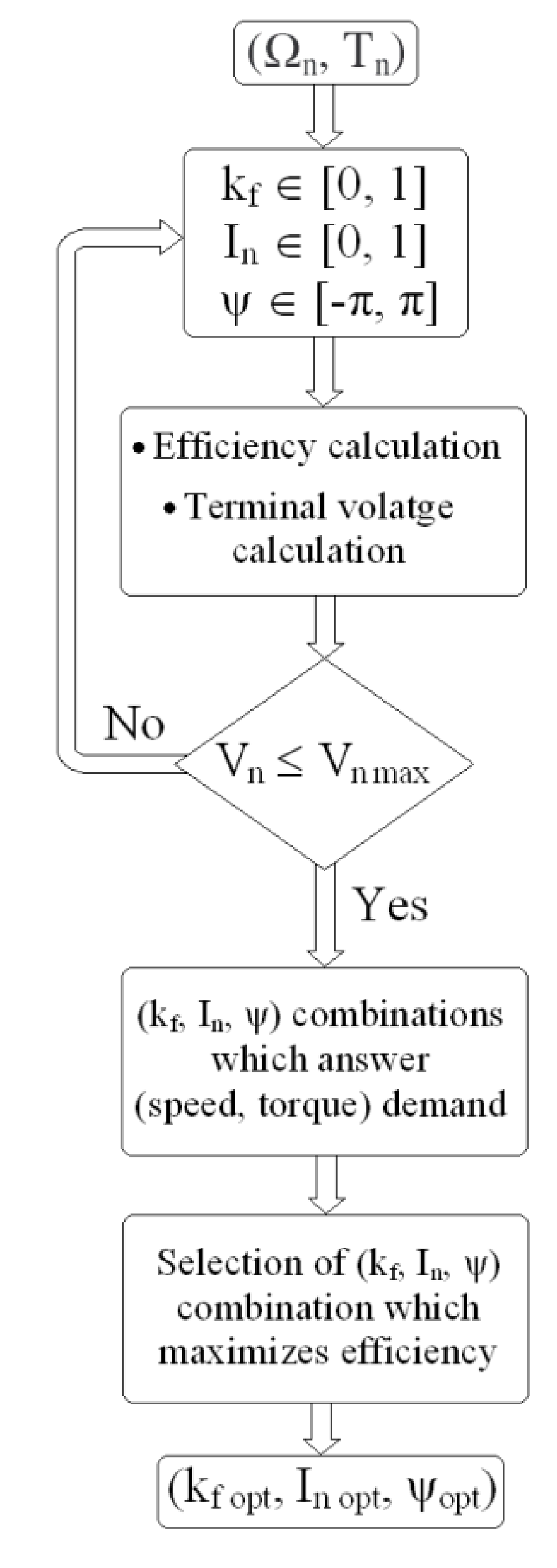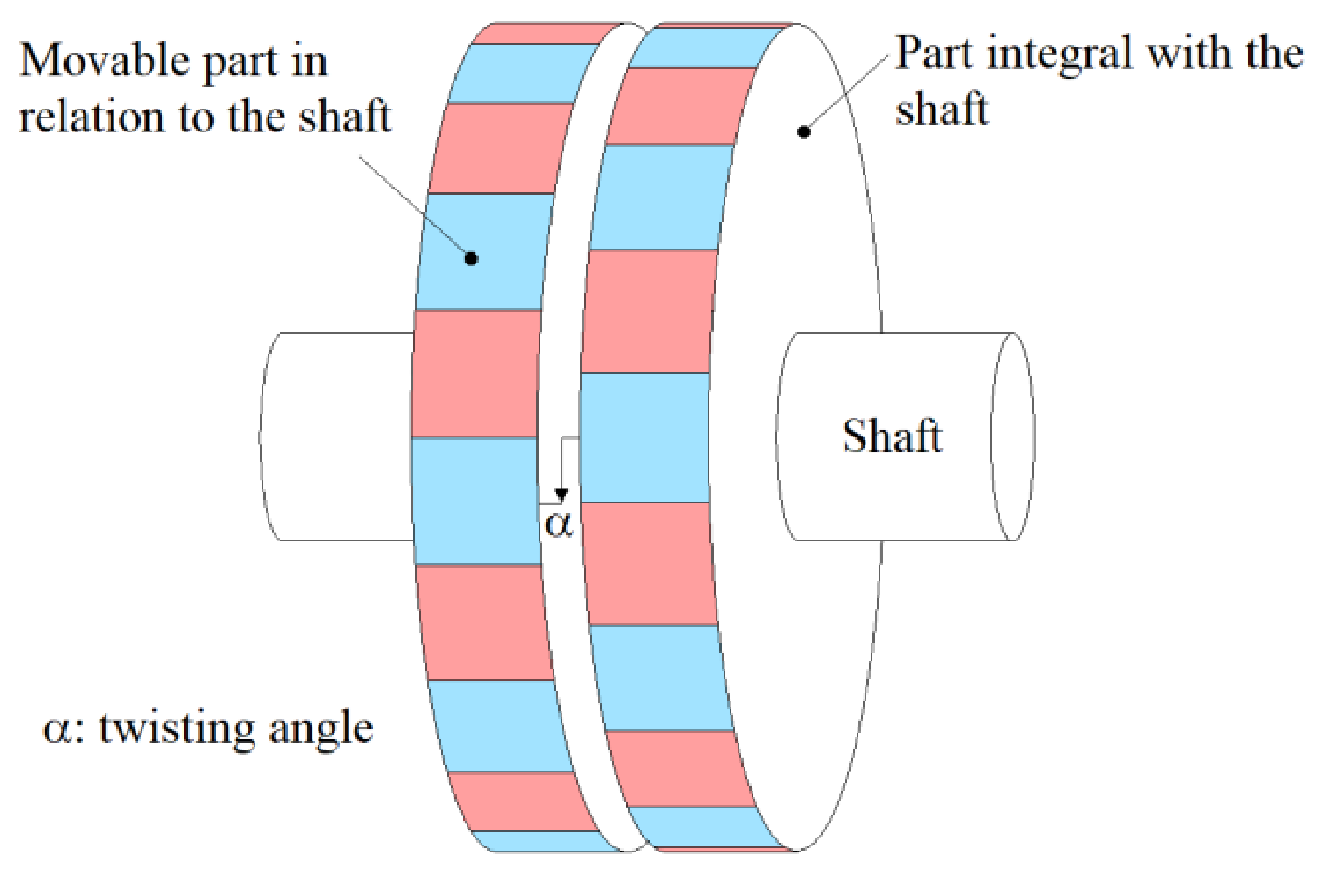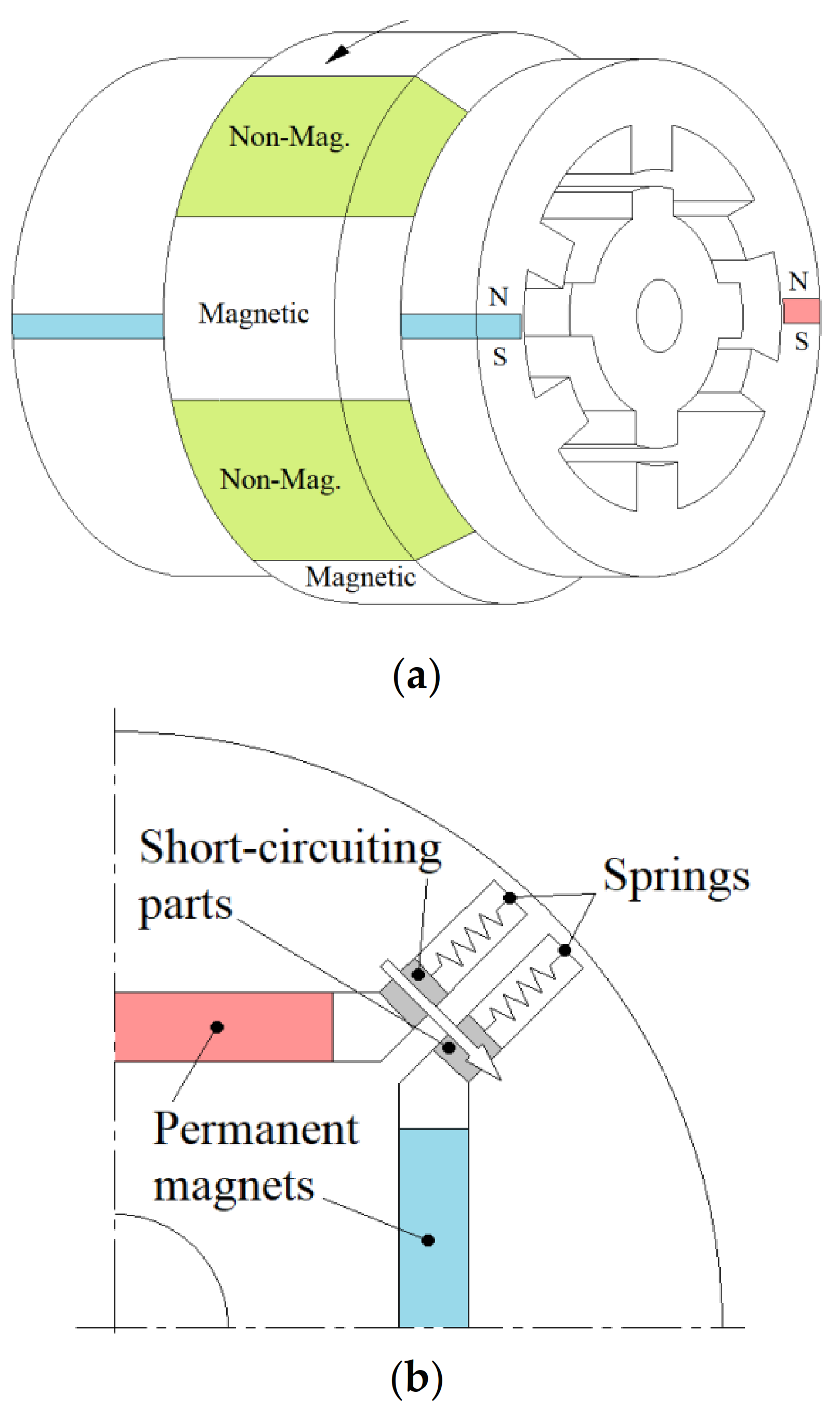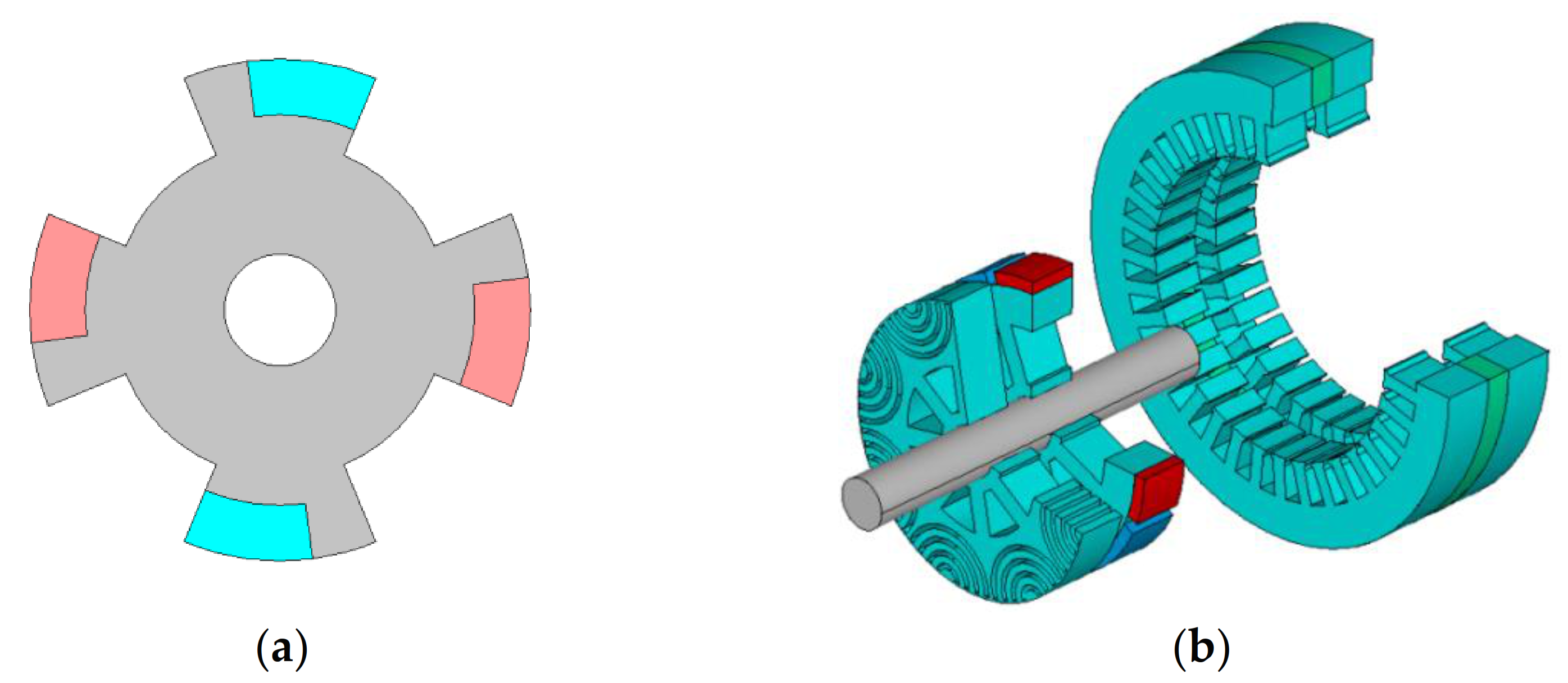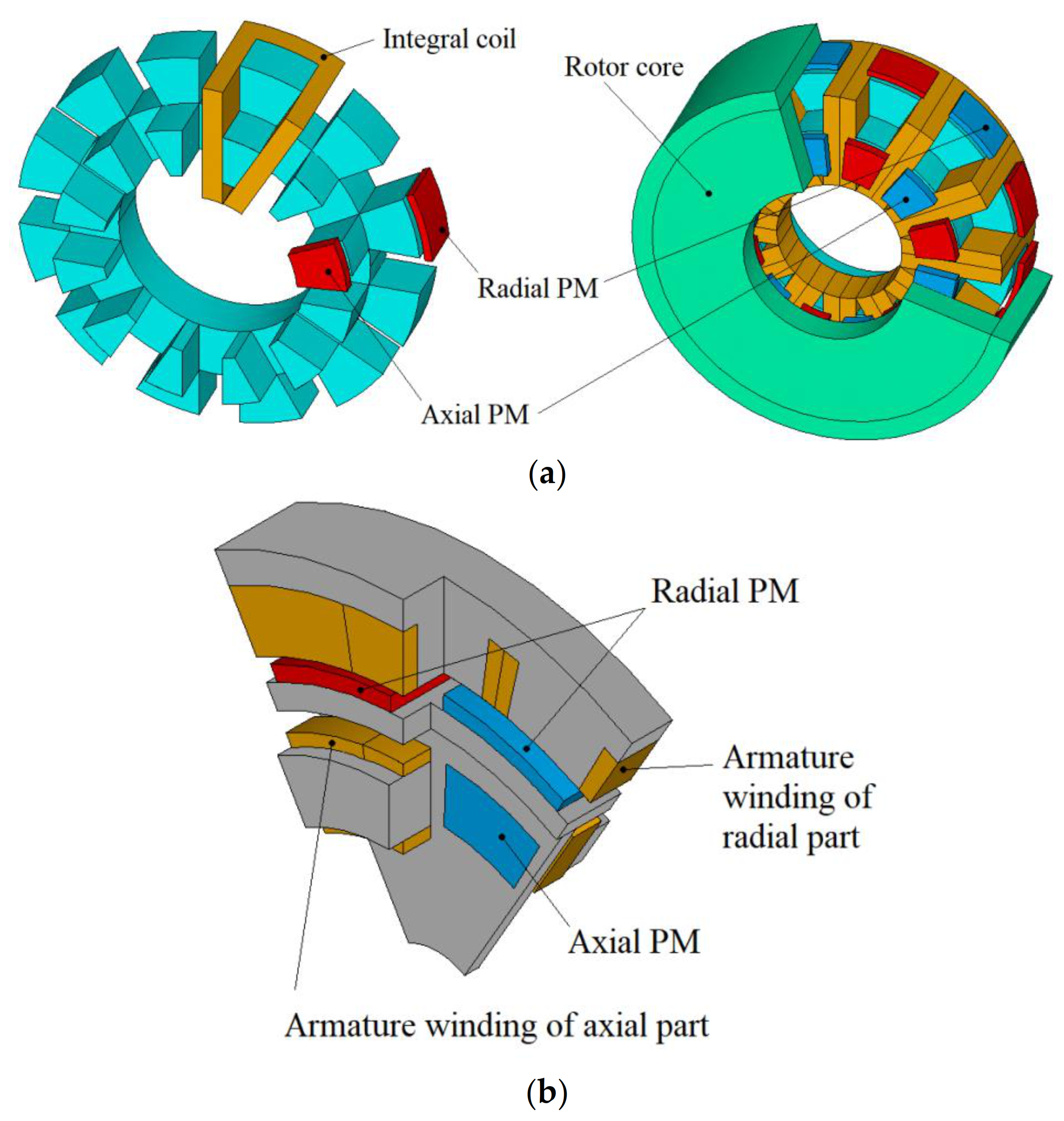Overview of Degrees of Freedom in the Design of PM Synchronous Machines †
Abstract
1. Introduction
2. Degrees of Freedom Identification
2.1. PM Torque Component
2.2. Reluctance Torque Component
- (1)
- A non-salient PM machine;
- (2)
- A synchronous reluctance machine.
- (1)
- One for the non-salient PM machine (dPM, qPM);
- (2)
- One for the synchronous reluctance machine (dReluc., qReluc.).
3. Structures with Additional Degrees of Freedom
3.1. Pole Changing PM Machines
3.2. Hybrid Excited Synchronous Machines
3.3. Variable Flux Memory Machines
3.4. Machines with Mechanically Controllable Air-Gap Flux
3.5. Inductance Axis Shifted Machines
3.6. Machines with Magnetic Gearing Effect
3.7. Passive Rotor PM Machines
3.8. Line-Starting PM Machines
3.9. Improved Use of the Available Space
3.10. Mechanical Modularity and Integration
4. Idea Stimulation
5. Conclusions
Author Contributions
Funding
Institutional Review Board Statement
Informed Consent Statement
Data Availability Statement
Conflicts of Interest
References
- Sarlioglu, B.; Morris, C.T.; Han, D.; Li, S. Driving toward accessibility: A review of technological improvements for electric machines, power electronics, and batteries for electric and hybrid vehicles. IEEE Ind. Appl. Mag. 2017, 23, 14–25. [Google Scholar] [CrossRef]
- Marc Debruyne. L’AGV et les Trains du Future; Club EEA: Lille, France, 2009. [Google Scholar]
- Product Note: Wind Power Generators: Medium Speed Permanent Magnet Generator (MS PMG), © Copyright 2012 ABB. All Rights Reserved. Available online: https://search.abb.com/library/Download.aspx?DocumentID=9AKK105541&LanguageCode=en&DocumentPartId=&Action=Launch (accessed on 1 July 2021).
- Siemens Showcases New Gearless Direct Drive Wind Generator (Germany). Available online: https://www.offshorewind.biz/2012/09/20/siemens-showcases-new-gearless-direct-drive-wind-generator-germany/ (accessed on 1 July 2021).
- Haliade 150-6MW Offshore Wind Turbine. Available online: http://pdf.archiexpo.com/pdf/alstom/haliade-150-6mw-offshore-wind-turbine-wallchart/88574-260511.html (accessed on 1 July 2021).
- The Offshore Wind Farm and Wind Power Industry. Available online: https://www.ge.com/renewableenergy/wind-energy/offshore-wind (accessed on 1 July 2021).
- Braha, D.; Maimon, O. The design process: Properties, paradigms, and structure. IEEE Trans. Syst. Man Cybern. Part A Syst. Hum. 1997, 27, 146–166. [Google Scholar] [CrossRef]
- Braha, D.; Maimon, O. A Mathematical Theory of Design: Foundations, Algorithms and Applications; Applied Optimization; Springer-Science and Business Media, B.V.: Berlin/Heidelberg, Germany, 1998; Volume 17. [Google Scholar] [CrossRef]
- Golovanov, D.; Gerada, D.; Sala, G.; Degano, M.; Trentin, A.; Connor, P.H.; Xu, Z.; La Rocca, A.; Galassini, A.; Tarisciotti, L.; et al. 4MW Class High Power Density Generator for Future Hybrid-Electric Aircraft. IEEE Trans. Transp. Electrif. 2021. [Google Scholar] [CrossRef]
- Zhang, Z.; Matveev, A.; Øvrebø, S.; Nilssen, R.; Nysveen, A. State of the art in generator technology for offshore wind energy conversion systems. In Proceedings of the 2011 IEEE International Electric Machines and Drives Conference (IEMDC 2011), Niagara Falls, ON, Canada, 15–18 May 2011; pp. 1131–1136. [Google Scholar]
- Ostovic, V. Pole-changing permanent-magnet machines. IEEE Trans. Ind. Appl. 2002, 38, 1493–1499. [Google Scholar] [CrossRef]
- Akemakou, A.D.; Phounsombat, S.K. Electrical Machine with Double Excitation, Especially a Motor Vehicle Alternator. U.S. Patent 6147429, 14 November 2000. [Google Scholar]
- Amara, Y.; Vido, L.; Gabsi, M.; Haong, E.; Ben Ahmed, A.H.; Lécrivain, M. Hybrid excitation synchronous machines: Energy-efficient solution for vehicles propulsion. IEEE Trans. Veh. Technol. 2009, 58, 2137–2149. [Google Scholar] [CrossRef]
- Hlioui, S.; Gabsi, M.; Ben Ahmed, H.; Barakat, G.; Amara, Y.; Chabour, F.; Paulides, J.J.H. Hybrid Excited Synchronous Machines. IEEE Trans. Magn. 2021. [Google Scholar] [CrossRef]
- Capolino, G.-A.; Cavagnino, A. New trends in electrical machines technology—Part II. IEEE Trans. Ind. Electron. 2014, 61, 4931–4936. [Google Scholar] [CrossRef]
- Liu, C.; Chau, K.T.; Kirtley, J.L.; Chan, C.C.; Rajashekara, K.; Cheng, M.; Jahns, T.M.; Zhang, Z.; Kwon, B.; Shek, J.; et al. Guest Editorial Emerging Electric Machines and Drives for Smart Energy Conversion. IEEE Trans. Energy Convers. 2018, 33, 1931–1933. [Google Scholar] [CrossRef]
- Akatsu, K.; Sugimoto, H.; Aiso, K.; Gao, Y.; Fernandez, D.; Matsumori, H. Message from Editors. CES Trans. Electr. Mach. Syst. 2019, 3, 231–232. [Google Scholar] [CrossRef]
- Spooner, E.; Khatab, S.A.W.; Nicolaou, N.G. Hybrid excitation of AC and DC machines. In Proceedings of the 1989 Fourth International Conference Electrical Machines and Drives Conference, London, UK, 13–15 September 1989; pp. 48–52. [Google Scholar]
- Amara, Y.; Hlioui, S.; Ben Ahmed, H.; Gabsi, M. Pre-optimization of hybridization ratio in hybrid excitation synchronous machines using electrical circuits modelling. Math. Comput. Simul. 2021, 184, 118–136. [Google Scholar] [CrossRef]
- Nasr, A.; Hlioui, S.; Gabsi, M.; Mairie, M.; Lalevee, D. Design optimization of a hybrid-excited flux-switching machine for aircraft-safe DC power generation using a diode bridge rectifier. IEEE Trans. Ind. Electron. 2017, 64, 9896–9904. [Google Scholar] [CrossRef]
- Richard, D.; Dubel, Y. Valeo stars technology: A competitive solution for hybridization. In Proceedings of the 2007 Power Conversion Conference, Nagoya, Japan, 2–5 April 2007; pp. 1601–1605. [Google Scholar]
- Albert, L. Modélisation et Optimisation des Alternateurs à griffes. Application au Domaine Automobile. Ph.D. Thesis, Energie électrique, Institut National Polytechnique de Grenoble-INPG, Grenoble, France, 2004. (In French). [Google Scholar]
- Ostovic, V. Memory motors—A new class of controllable flux PM machines for a true wide speed operation. In Proceedings of the Conference Record IEEE-IAS Annual Meeting, 30 September–4 October 2001; pp. 2577–2584. [Google Scholar] [CrossRef]
- Yang, H.; Lin, H.; Zhu, Z.Q. Recent advances in variable flux memory machines for traction applications: A review. CES Trans. Electr. Mach. Syst. 2018, 2, 34–50. [Google Scholar] [CrossRef]
- Lipo, T.A.; Aydin, M. Field weakening of permanent magnet machines–Design approaches. In Proceedings of the EPE Power Electronics and Motion Control Conference (EPE-PEMC 04), Riga, Latvia, 1–24 June 2013. [Google Scholar]
- John, M.M. Propulsion Systems for Hybrid Vehicles, 2nd ed.; IET Renewable Energy Series 7; IET Renewable Energy, 2010.
- Lawrence, P.Z.; Jerry, W.M. Brushless Permanent Magnet Motor with Variable Axial Rotor/Stator Alignment to Increase Speed Capability. U.S. Patent 6,492,753 B2, 10 December 2002. [Google Scholar]
- Kraβer, B.; Rattei, F. Mechanical Field Weakening with Actuation by the Stator Currents. In Proceedings of the International Conference on Electrical Machines, Helsinki, Finland, 28–30 August 2000; Volume 4, pp. 1956–1960. [Google Scholar]
- Rattei, F.; Kraβer, B. Efficiency of a permanent magnet polyphase machine with a mechanical field weakening. In Proceedings of the EPE’99 EPFL, Lausanne, Switzerland, 7–9 September 1999. [Google Scholar]
- Thomas, A.L.; Liao, Y.; Liang, F. Field Weakening for a Doubly Salient Motor with Stator Permanent Magnets. U.S. Patent 5,455,473, 3 October 1995. [Google Scholar]
- Lei, M.; Sanada, M.; Morimoto, S.; Takeda, Y. Basic study of flux-weakening for interior permanent magnet synchronous motor with moving iron piece. IEEJ Trans. Ind. Appl. 1998, 118, 1458–1459. (In Japanese) [Google Scholar] [CrossRef][Green Version]
- Zhao, W.; Lipo, T.A.; Kwon, B.-I. Optimal design of a novel asymmetrical rotor structure to obtain torque and efficiency improvement in surface inset PM motors. IEEE Trans. Magn. 2015, 51, 8100704. [Google Scholar] [CrossRef]
- Zhao, W.; Chen, D.; Lipo, T.A.; Kwon, B.-I. Performance improvement of ferrite-assisted synchronous reluctance machines using asymmetrical rotor configurations. IEEE Trans. Magn. 2015, 51, 8108504. [Google Scholar] [CrossRef]
- Yang, H.; Li, Y.; Lin, H.; Zhu, Z.Q.; Lyu, S.; Wang, H.; Fang, S.; Huang, Y. Novel reluctance axis shifted machines with hybrid rotors. In Proceedings of the 2017 IEEE Energy Conversion Congress and Exposition (ECCE), Cincinnati, OH, USA, 1–5 October 2017. [Google Scholar] [CrossRef]
- Takahashi, T.; Miyama, Y.; Nakano, M.; Yamane, K. Permanent Magnet Rotating Electric Machine. Japan PCT Patent Appl. WO 2019/064801 A1, 4 April 2019. [Google Scholar]
- Zhu, Z.Q.; Xiao, Y. Novel Magnetic-field-shifting Techniques in Asymmetric Rotor Pole Interior PM Machines with Enhanced Torque Density. IEEE Trans. Magn. 2021. [Google Scholar]
- Zhu, Z.Q.; Chen, J.T.; Pang, Y.; Howe, D.; Iwasaki, S.; Deodhar, R. Analysis of a novel multi-tooth flux-switching PM brushless AC machine for high torque direct-drive applications. IEEE Trans. Magn. 2008, 44, 4313–4316. [Google Scholar] [CrossRef]
- Lee, C.H. Vernier motor and its design. IEEE Trans. Power App. Syst. 1963, 82, 343–349. [Google Scholar] [CrossRef]
- Kim, B.; Lipo, T.A. Operation and design principles of a PM Vernier motor. IEEE Trans. Ind. Appl. 2014, 50, 3656–3663. [Google Scholar] [CrossRef]
- Xu, L. Dual-mechanical-port electric machines-concept and application of a new electric machine to hybrid electrical vehicles. IEEE Ind. Appl. Mag. 2009, 15, 44–51. [Google Scholar] [CrossRef]
- Sun, X.; Cheng, M.; Hua, W.; Xu, L. Optimal design of double-layer permanent magnet dual mechanical port machine for wind power application. IEEE Trans. Magn. 2009, 45, 4613–4616. [Google Scholar] [CrossRef]
- Atallah, K.; Rens, J.; Mezani, S.; Howe, D. A novel “pseudo” direct-drive brushless permanent magnet machine. IEEE Trans. Magn. 2008, 44, 4349–4352. [Google Scholar] [CrossRef]
- Li, D.; Qu, R.; Li, J. Topologies and analysis of flux-modulation machines. In Proceedings of the IEEE Energy Conversion Congres Exposition, Montreal, QC, Canada, 20–24 September 2015; pp. 2153–2160. [Google Scholar] [CrossRef]
- Tong, C.; Wang, M.; Zheng, P.; Bai, J.; Liu, J. Characteristic analysis and functional validation of a brushless flux-modulated double-rotor machine for HEVs. IEEE Trans. Indus. Electron. 2019, 66, 663–673. [Google Scholar] [CrossRef]
- Magnomatics: Wind Energy Activity. Available online: http://www.magnomatics.com/pages/applications/renewable-energy.htm (accessed on 1 July 2021).
- Holehouse, R.C.; Atallah, K.; Wang, J. Design and realization of a linear magnetic gear. IEEE Trans. Magn. 2011, 47, 4171–4174. [Google Scholar] [CrossRef]
- Girtan, M.; Wittenberg, A.; Grilli, M.L.; de Oliveira, D.P.S.; Giosuè, C.; Ruello, M.L. The Critical Raw Materials Issue between Scarcity, Supply Risk, and Unique Properties. Materials 2021, 14, 1826. [Google Scholar] [CrossRef]
- Wang, Y.; Deng, Z. Hybrid Excitation Topologies and Control Strategies of Stator Permanent Magnet Machines for DC Power System. IEEE Trans. Ind. Electron. 2012, 59, 4601–4616. [Google Scholar] [CrossRef]
- Amara, Y.; Barakat, G.; Paulides, J.J.H.; Lomonova, E. Overload capability of linear flux switching permanent magnet machines. In Proceedings of the Ninth International Symposium on Linear Drives for Industry Applications (LDIA13), Applied Mechanics and Materials, Hangzhou, China, 7–10 July 2013; Volume 416–417, pp. 345–352. [Google Scholar] [CrossRef]
- Yang, H.; Zhu, Z.Q.; Lin, H.; Chu, W. Flux adjustable permanent magnet machines: A technology status review. Chin. J. Electr. Eng. 2016, 2, 14–30. [Google Scholar] [CrossRef]
- Zeng, Z.; Lu, Q. Investigation of novel partitioned-primary hybrid-excited flux-switching linear machines. IEEE Trans. Ind. Electron. 2018, 65, 9804–9813. [Google Scholar] [CrossRef]
- Zeng, Z.; Lu, Q. A novel hybrid-excitation switched-flux linear machine with partitioned-excitations. IEEE Trans. Magn. 2019, 55, 7502204. [Google Scholar] [CrossRef]
- Jha, A.K. Optimization of Line Start Permanent Magnet Synchronous Motor for Magnet Cost Reduction. Master’s Thesis, Royal Institute of Technology, The School of Electrical Engineering, Electrical Energy Conversion, Stockholm, Sweden, 2012. [Google Scholar]
- Miller, T.J.E. Synchronization of line-start permanent-magnet AC motors. IEEE Trans. Power Appl. Syst. 1984, 103, 1822–1828. [Google Scholar] [CrossRef]
- Knight, A.M.; McClay, C.I. The design of high-efficiency line-Start motors. IEEE Trans. Ind. Appl. 2000, 36, 1555–1562. [Google Scholar] [CrossRef]
- Kurihara, K.; Azizur Rahman, M. High-efficiency line-start interior permanent-magnet synchronous motors. IEEE Trans. Ind. Appl. 2004, 40, 789–796. [Google Scholar] [CrossRef]
- Ding, T.; Takorabet, N.; Sargos, F.-M.; Wang, X. Design and analysis of different line-start PM synchronous motors for oil-pump applications. IEEE Trans. Magn. 2009, 45, 1816–1819. [Google Scholar] [CrossRef]
- Mingardi, D.; Bianchi, N. Line-start PM-assisted synchronous motor design, optimization, and tests. IEEE Trans. Indus. Electron. 2017, 64, 9739–9747. [Google Scholar] [CrossRef]
- Sorgdrager, A.J.; Wang, R.-J.; Grobler, A.J. Multiobjective design of a line-start PM motor using the Taguchi method. IEEE Trans. Ind. Appl. 2018, 54, 4167–4176. [Google Scholar] [CrossRef]
- Yan, B.; Wang, X.; Yang, Y. Comparative parameters investigation ofcomposite solid rotor applied to line-start permanent-magnet synchronousmotors. IEEE Trans. Magn. 2018, 54, 8206305. [Google Scholar] [CrossRef]
- Wymeersch, B.; De Belie, F.; Rasmussen, C.B.; Vandevelde, L. Classification Method to Define Synchronization Capability Limits of Line-Start Permanent-Magnet Motor Using Mesh-Based Magnetic Equivalent Circuit Computation Results. Energies 2018, 11, 998. [Google Scholar] [CrossRef]
- Zöhra, B.; Akar, M.; Eker, M. Design of A Novel Line Start Synchronous Motor Rotor. Electronics 2019, 8, 25. [Google Scholar] [CrossRef]
- Knypiński, Ł.; Pawełoszek, K.; Le Menach, Y. Optimization of Low-Power Line-Start PM Motor Using Gray Wolf Metaheuristic Algorithm. Energies 2020, 13, 1186. [Google Scholar] [CrossRef]
- Sitapati, K.; Krishnan, R. Performance comparisons of radial and axial field, permanent-magnet, brushless machines. IEEE Trans. Ind. Appl. 2001, 37, 1219–1226. [Google Scholar] [CrossRef]
- Jack, A.G.; Mecrow, B.C.; Maddison, C.P. Combined radial and axial permanent magnet motors using soft magnetic composites. In Proceedings of the 9th IEMDC, Seattle, WA, USA, 9–12 May 1999; pp. 25–29. [Google Scholar] [CrossRef]
- Wei, X.; Yang, K.; Pan, Z.; Xie, H.; Zhu, C.; Zhang, Y. Design of a novel axial-radial flux permanent magnet motor. In Proceedings of the 17th ICEMS, Hangzhou, China, 24–25 October 2014; pp. 80–84. [Google Scholar] [CrossRef]
- Seo, J.M.; Ro, J.-S.; Rhyu, S.-H.; Jung, I.-S.; Jung, H.-K. Novel hybrid radial and axial flux permanent-magnet machine using integrated windings for high-power density. IEEE Trans. Magn. 2015, 51, 8100804. [Google Scholar] [CrossRef]
- Ishikawa, T.; Amada, S.; Segawa, K.; Kurita, N. Proposal of a radial- and axial-flux permanent-magnet synchronous generator. IEEE Trans. Magn. 2017, 53, 8105204. [Google Scholar] [CrossRef]
- Rioux, C. Théorie générale comparative des machines électriques établie à partir des équations du champ électromagnétique. RGE 1970, 79, 415–421. [Google Scholar]
- Rioux, C. Aspects préliminaires de la théorie des machines électriques comportant des matériaux ferromagnétiques. Rev. Phys. Appl. 1980, 15, 1505–1515. [Google Scholar] [CrossRef]
- Ben Ahmed, H.; Prevond, L.; Multon, B. Structures polyentrefers: Solutions pour les entrainements directs? In Proceedings of the Colloque Conversion Electromécanique Directe (CEMD), Cachan, France, 4 February 1999; pp. 95–100. Available online: https://hal.archives-ouvertes.fr/hal-00674080/document (accessed on 1 July 2021).
- Vermaak, R.; Kamper, M.J. Design Aspects of a Novel Topology Air-Cored Permanent Magnet Linear Generator for Direct Drive Wave Energy Converters. IEEE Trans. Indus. Electron. 2012, 59, 2104–2115. [Google Scholar] [CrossRef]
- Enrici, P.; Dumas, F.; Matt, D. Impact of the assembly constraints on a multi-air gap linear motor. In Proceedings of the 2012 International Conference on Electrical Machines (ICEM), Marseille, France, 2–5 September 2012; 2012. [Google Scholar] [CrossRef]
- EL-Refaie, A.M. Integrated electrical machines and drives: An overview. In Proceedings of the 2015 IEEE International Electric Machines & Drives Conference (IEMDC), Coeur d’Alene, ID, USA, 10–13 May 2015. [Google Scholar] [CrossRef]
- Al Ghossini, H.; Dang, T.T.; Duchesne, S. A New Concept for Deeper Integration of Converters and Drives in Electrical Machines: Simulation and Experimental Investigations. Open Phys. 2019, 17, 809–815. [Google Scholar] [CrossRef]
- Shrestha, G.; Polinder, H.; Bang, D.J.; Ferreira, J.A.; McDonald, A.S. A new concept for weight reduction of large direct drive machines. In Proceedings of the 2008 International Conference on Electrical Machines (ICEM), Vilamoura, Portugal, 6–9 September 2008. [Google Scholar] [CrossRef]
- Bang, D.-J.; Polinder, H.; Ferreira, J.A.; Hong, S.-S. Structural mass minimization of large direct-drive wind generators using a buoyant rotor structure. In Proceedings of the 2010 IEEE Energy Conversion Congress and Exposition, Atlanta, GA, USA, 12–16 September 2010. [Google Scholar] [CrossRef]
- Ausderau, D.; Hitz, M.; Rohner, R. Linear Motor. Europäisches Patentamt. EP 2390990A1, 25 May 2011. [Google Scholar]
- Maurus, Q.; Canders, W.-R.; Henke, M. Increasing the force per unit volume of tubular drives by raising the integration degree. In Proceedings of the 11th International Symposium on Linear Drives for Industry Applications (LDIA2017), Osaka, Japan, 6–8 September 2017; pp. 1–6. [Google Scholar]
- McDonald, A.S.; Mueller, M.A.; Polinder, H. Structural mass in direct-drive permanent magnet electrical generators. IET Renew. Power Gener. 2008, 2, 3–15. [Google Scholar] [CrossRef]
- Gjerde, S.S.; Undeland, T. Power conversion system for transformer-less offshore wind turbine. In Proceedings of the 2011 14th European Conference on Power Electronics and Applications, Birmingham, UK, 30 August–1 September 2011. [Google Scholar]
- Borgen, E. Introduction of the Sway Turbine ST10. In Proceedings of the IQPC 3rd International Conference Drivetrain Concepts for Wind Turbines, Bremen, Germany, 22–24 October 2012. [Google Scholar]
- Boldea, I.; Nasar, S.A. Linear Electric Actuators and Generators; Cambridge University Press: Cambridge, UK, 1997; ISBN 13978-0521480178. [Google Scholar]
- Gieras, J.F. Permanent Magnet Motor Technology: Design and Applications; CRC Press: Boca Raton, FL, USA, 2009; ISBN 13978-1420064407. [Google Scholar]
- Gieras, J.F.; Piech, Z.J.; Tomczuk, B. Linear Synchronous Motors: Transportation and Automation Systems; CRC Press: Boca Raton, FL, USA, 2017; ISBN 9781138072053. [Google Scholar]
- Boldea, I.; Tutelea, L. Reluctance Electric Machines: Design and Control; CRC Press: Boca Raton, FL, USA, 2018; ISBN 9780367733933. [Google Scholar]
- Jahns, T.M.; Soong, W.L. Pulsating torque minimization techniques for permanent magnet ac motor drives: A review. IEEE Trans. Indus. Electron. 1996, 43, 321–330. [Google Scholar] [CrossRef]
- Haidar, D.; Amara, Y. Mechanical Construction and Bearing Function Integration in Tubular Linear Flux Switching Machines. In Proceedings of the International Symposium on Linear Drives for Industry Application (LDIA2021), Wuhan, China, 1–3 July 2021. [Google Scholar]
- Fernando, N.; Hanin, F. Magnetic materials for electrical machine design and future research directions: A review. In Proceedings of the 2017 IEEE International Electric Machines and Drives Conference, Miami, FL, USA, 21–24 May 2017. [Google Scholar] [CrossRef]
- Shokrollahi, H.; Janghorban, K. Soft magnetic composite materials (SMCs). J. Mater. Process. Tech. 2007, 189, 1–12. [Google Scholar] [CrossRef]
- Krings, A.; Cossale, M.; Tenconi, A.; Soulard, J.; Cavagnino, A.; Boglietti, A. Magnetic materials used in electrical machines: A comparison and selection guide for early machine design. IEEE Ind. Appl. Mag. 2017, 23, 21–28. [Google Scholar] [CrossRef]
- Wu, F.; EL-Refaie, A.M. Toward additively manufactured electrical machines: Opportunities and challenges. IEEE Trans. Ind. Appl. 2020, 56, 1306–1320. [Google Scholar] [CrossRef]
- Wu, F.; EL-Refaie, A.M.; Al-Qarni, A. Additively Manufactured Hollow Conductors Integrated with Heat Pipes: Design Tradeoffs and Hardware Demonstration. IEEE Trans. Ind. Appl. 2021. [Google Scholar] [CrossRef]
- Ayat, S.; Simpson, N.; Dagusé, B.; Rudolph, J.; Lorenz, F.; Drury, D. Design of shaped-profile electrical machine windings for multi-material additive manufacture. In Proceedings of the 2020 International Conference on Electrical Machines (ICEM), Gothenburg, Sweden, 23–26 August 2020. [Google Scholar] [CrossRef]
- Gamba, M.; Pellegrino, G.; Cupertino, F. Optimal number of rotor parameters for the automatic design of Synchronous Reluctance machines. In Proceedings of the 2014 International Conference on Electrical Machines (ICEM), Berlin, Germany, 2–5 September 2014. [Google Scholar] [CrossRef]
- Chiu, M.-T.; Chiang, J.-A.; Lin, C.-H. Design and Optimization of a Novel V-Type Consequent-Pole Interior Permanent Magnet Synchronous Motor for Applying to Refrigerant Compressor. In Proceedings of the 21th ICEMS, Jeju, Korea, 7–10 October 2018; pp. 413–418. [Google Scholar] [CrossRef]
- Di Barbaa, P.; Mognaschia, M.E.; Rezaeia, N.; Lowther, D.A.; Rahman, T. Many-objective shape optimisation of IPM motors for electric vehicle traction. Int. J. Appl. Electromagn. Mech. 2019, 60, 149–162. [Google Scholar] [CrossRef]
- Mutluer, M. Analysis and Design Optimization of Tubular Linear Voice Coil Motor for High Thrust Force and Low Copper Loss. IEEE Can. J. Electr. Comput. Eng. 2021, 44, 165–170. [Google Scholar] [CrossRef]
- ENESYS. Available online: http://www.enesys.ruhr-uni-bochum.de/ueber_uns/index.html.en (accessed on 1 July 2021).
- Amara, Y.; Hlioui, S. Degrees of freedom in the design of PM synchronous machines. In Proceedings of the 19th International Symposium on Electromagnetic Fields in Machatronics, Electrical and Electronic Engineering, Nancy, France, 29–31 August 2019. [Google Scholar]
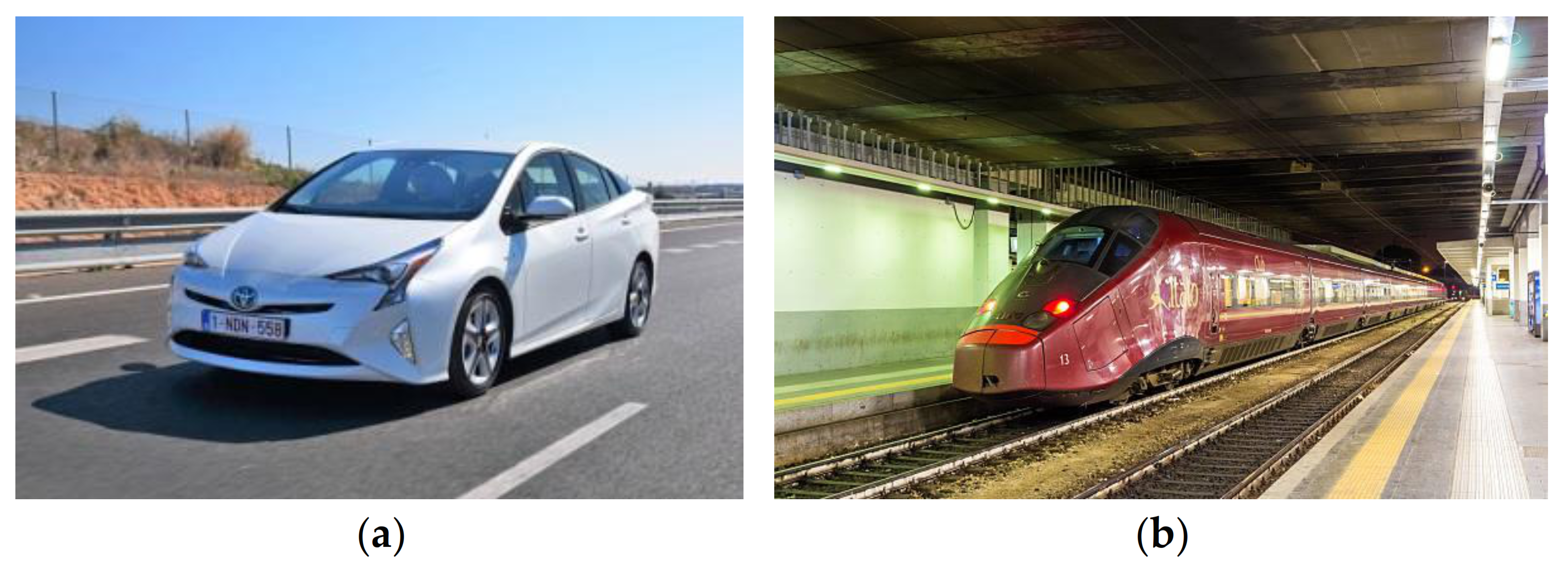
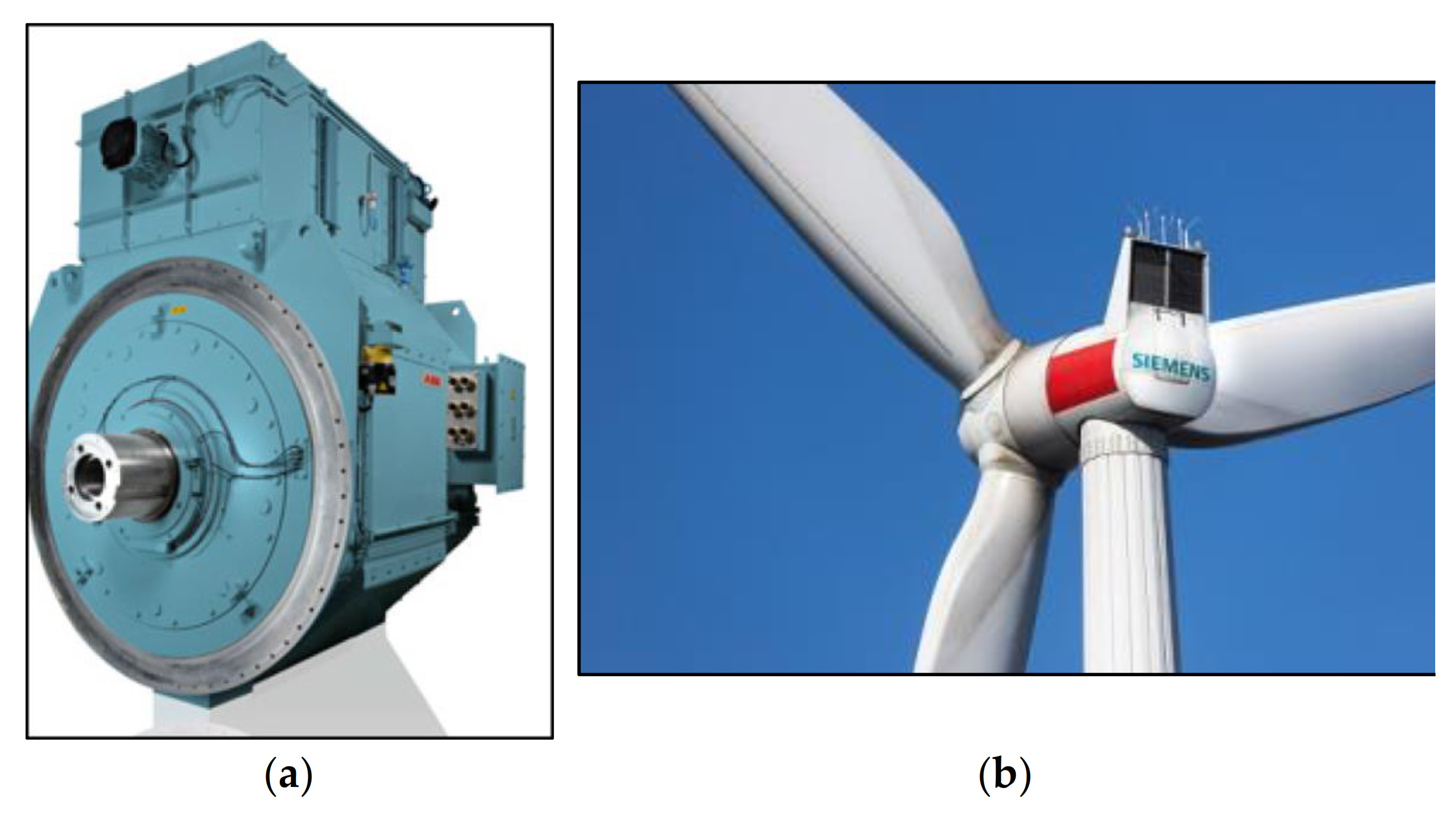
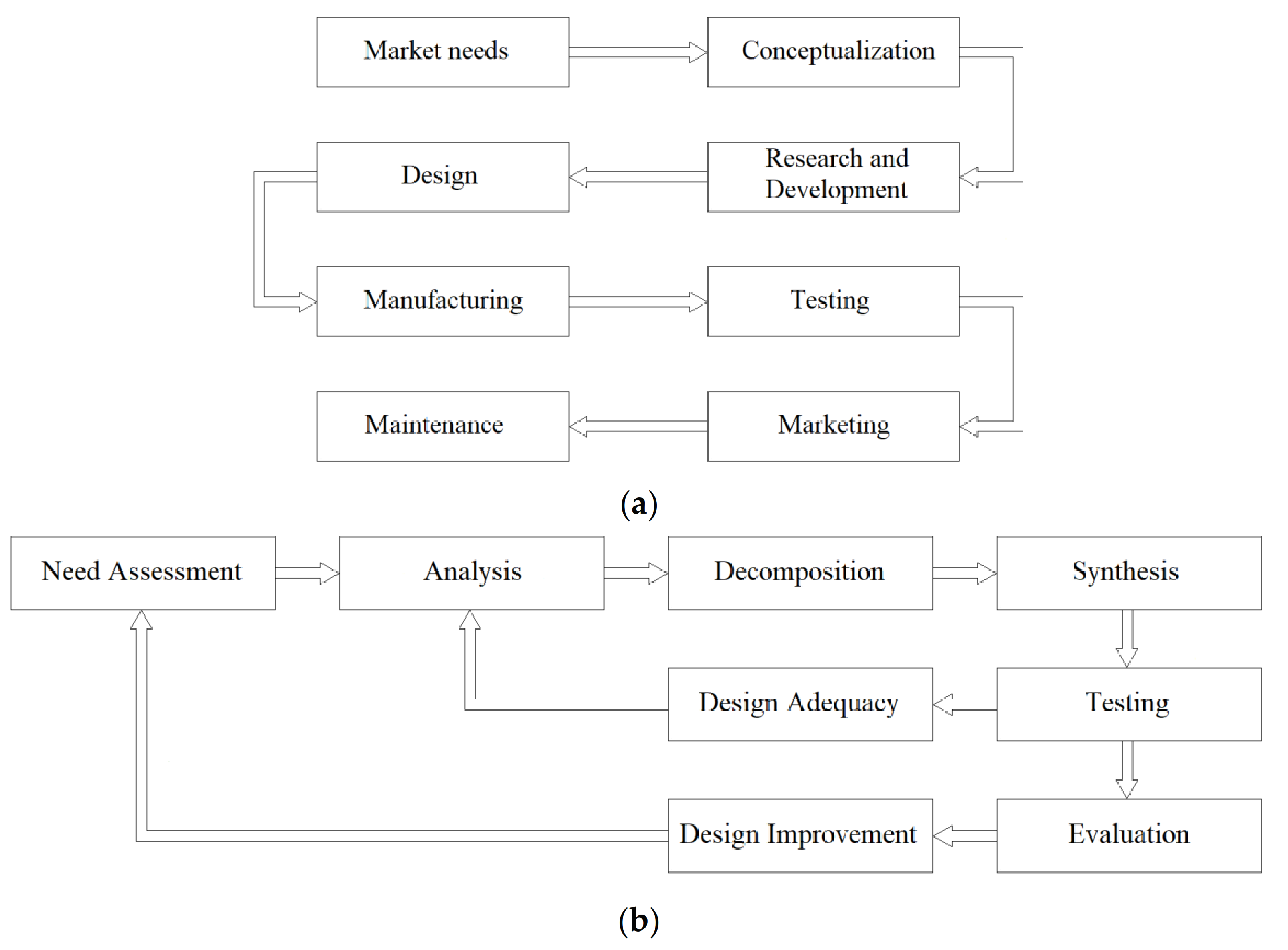
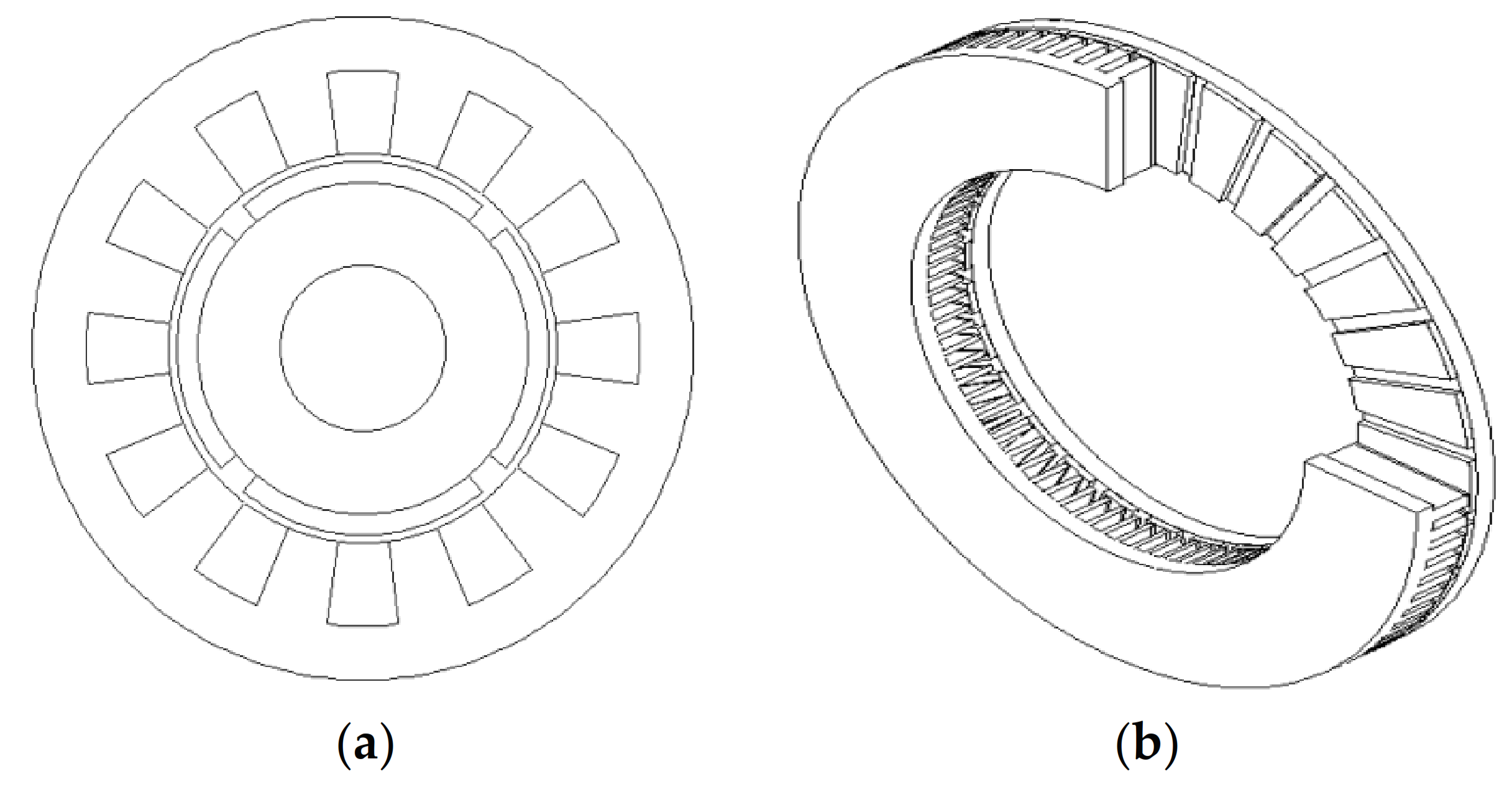
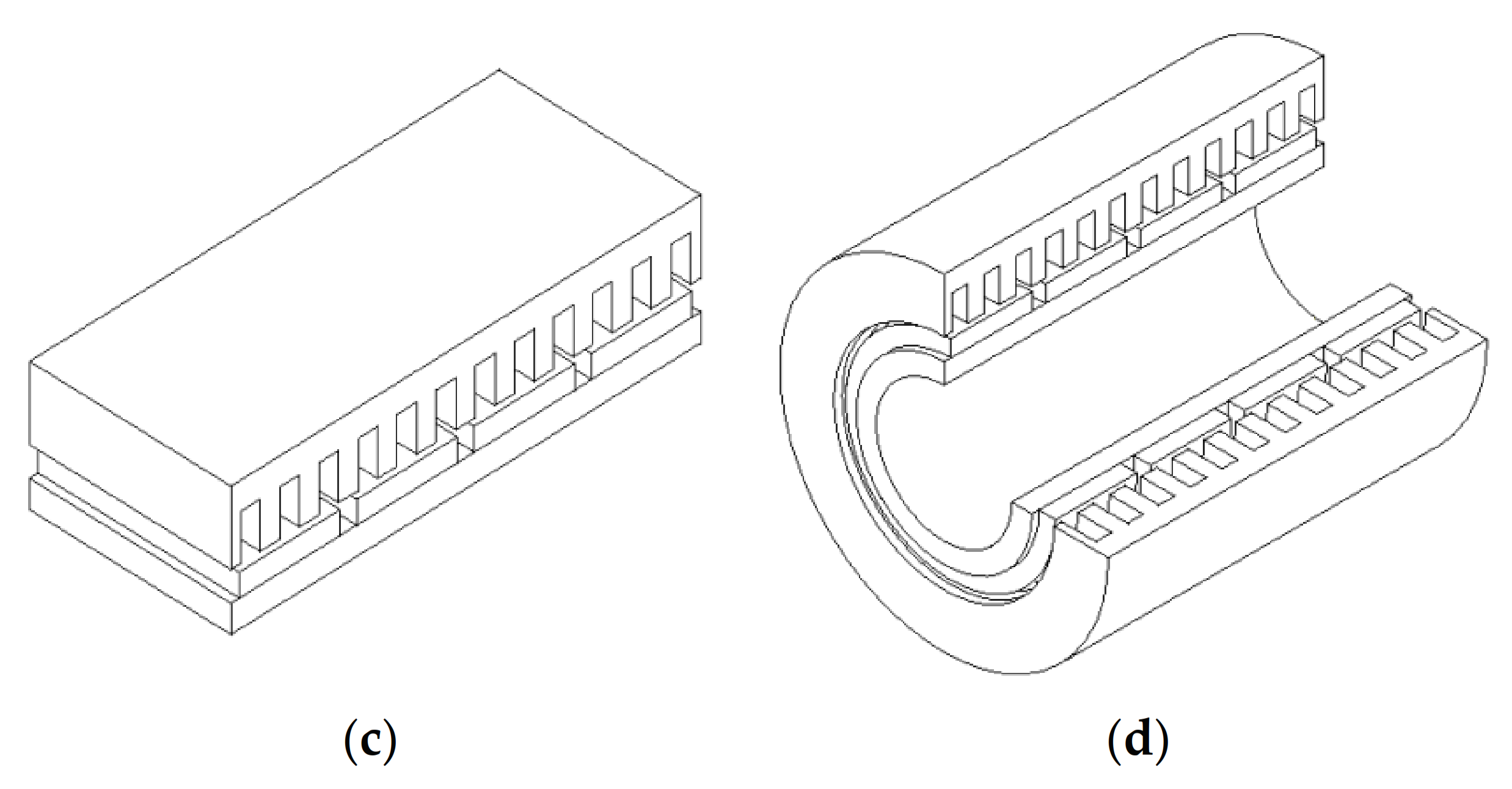
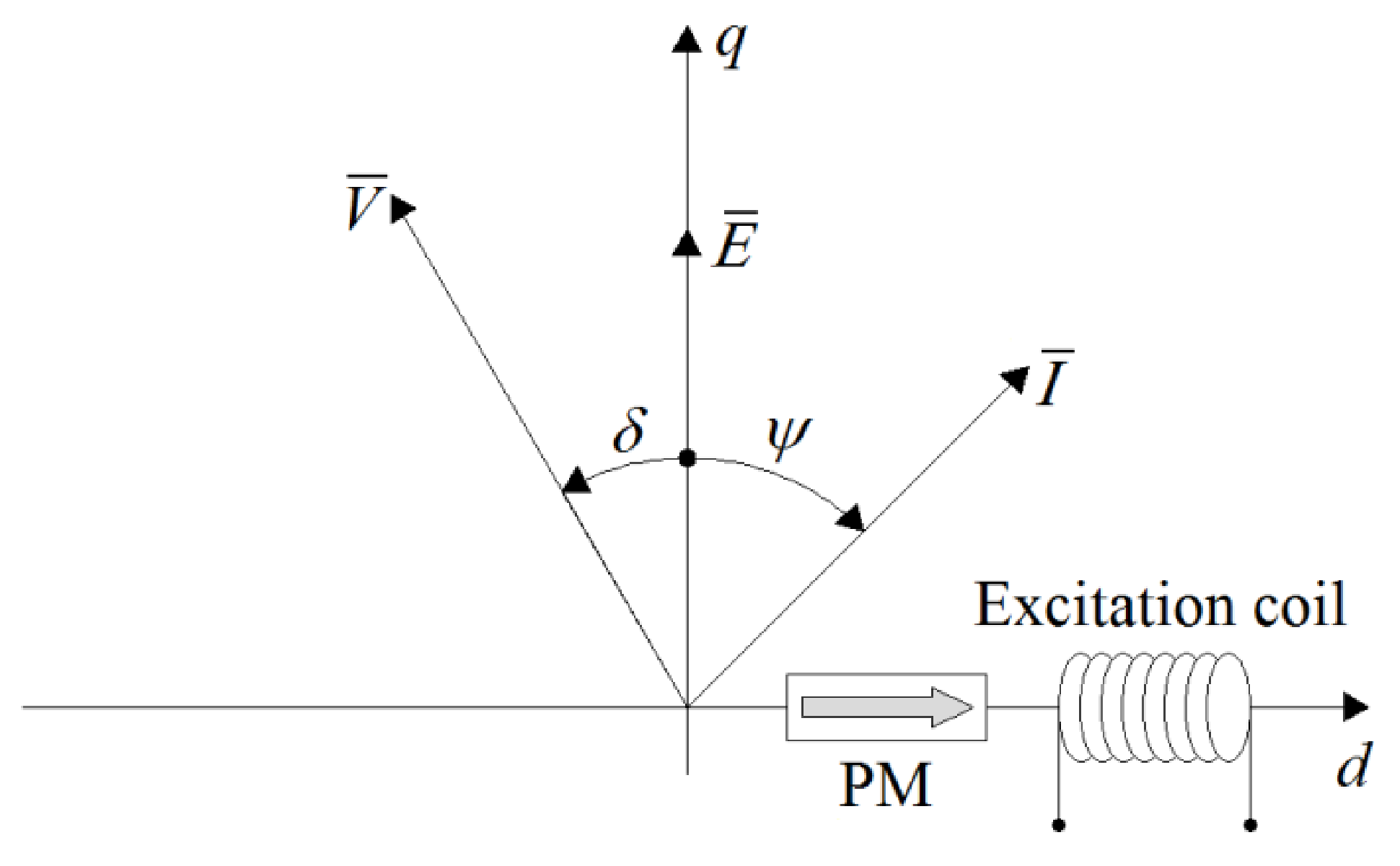
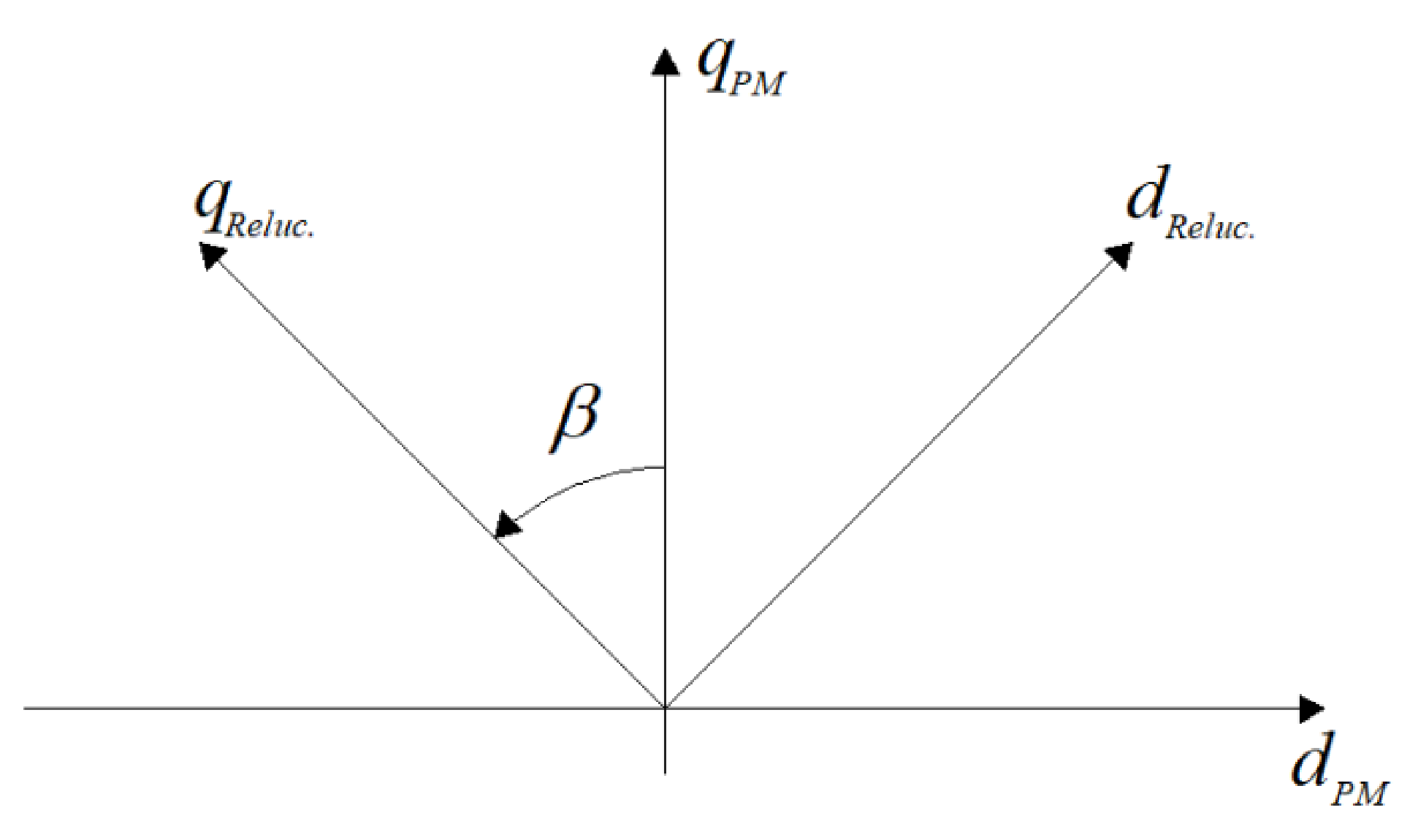
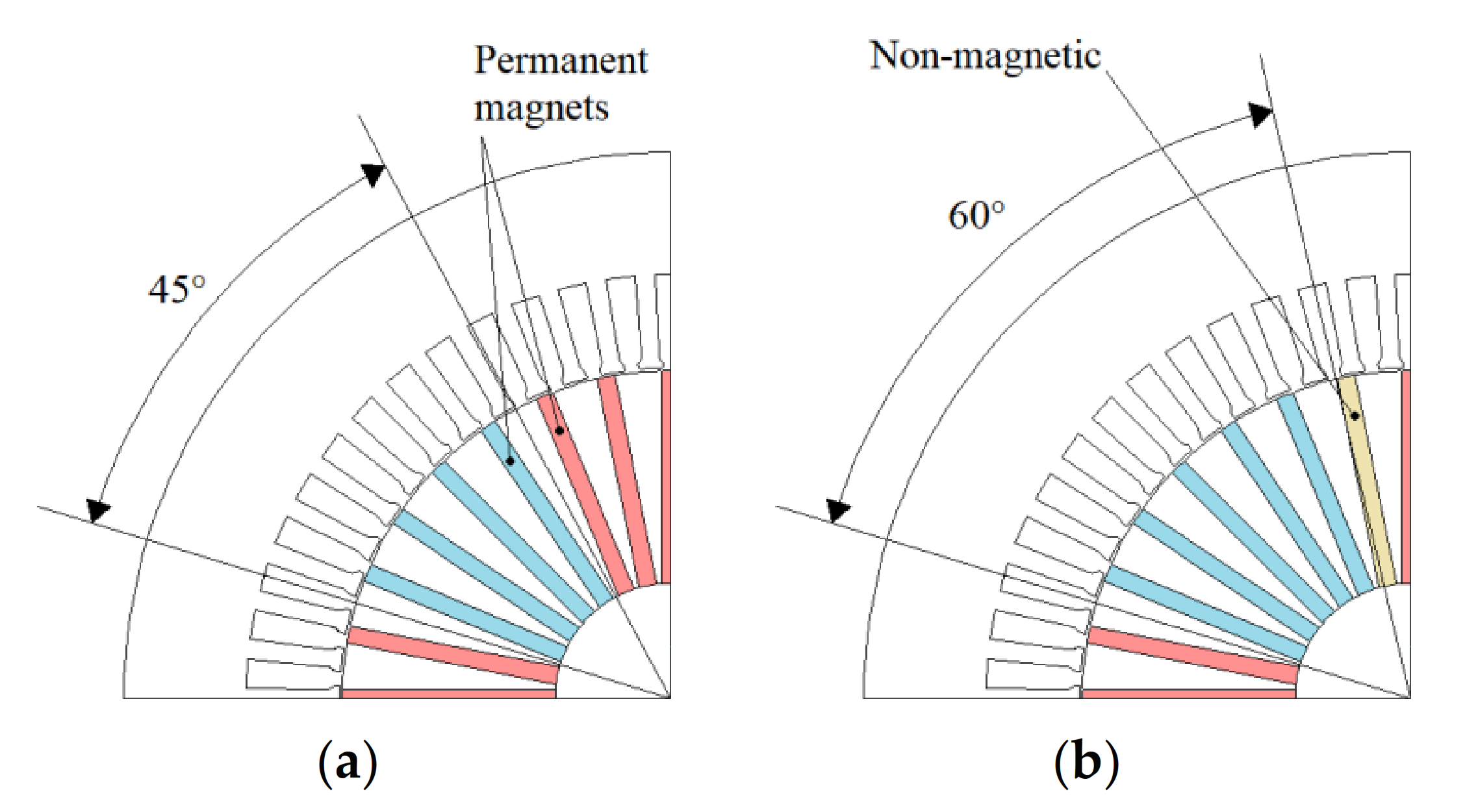

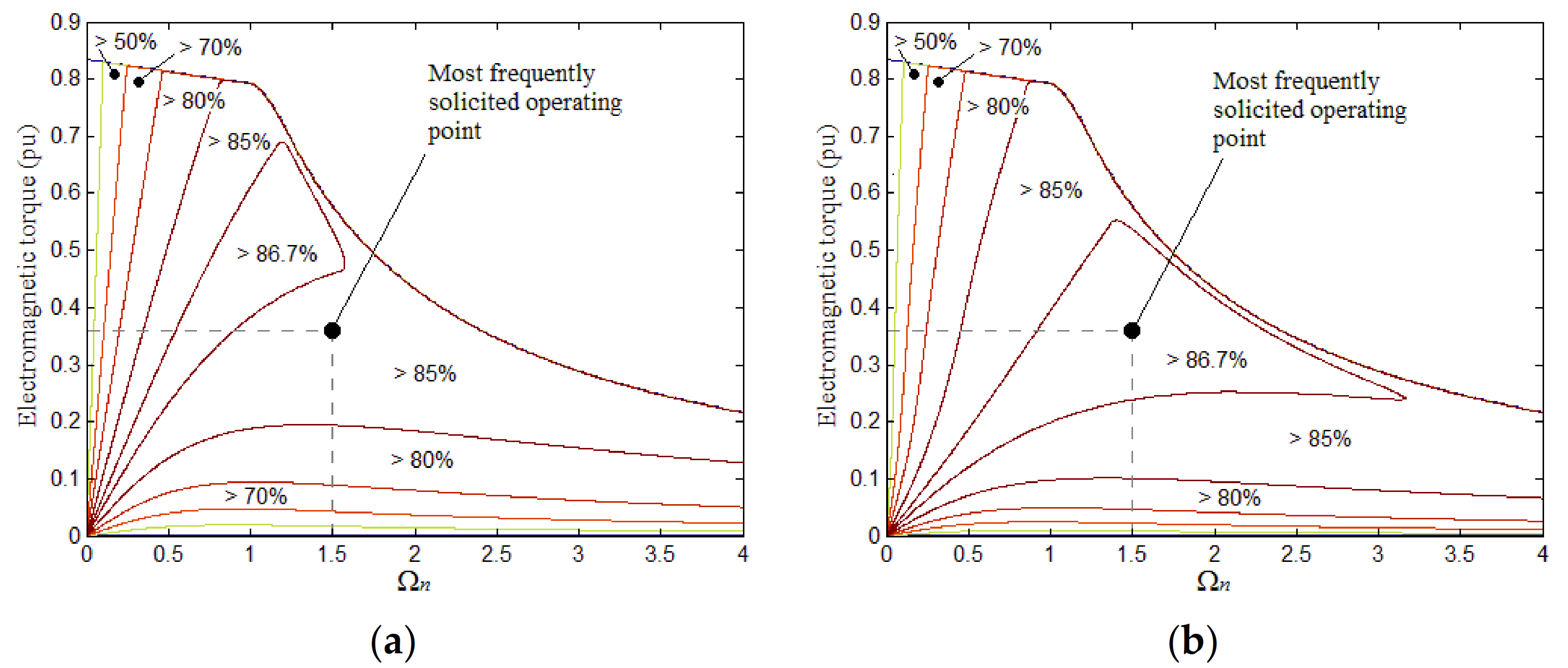
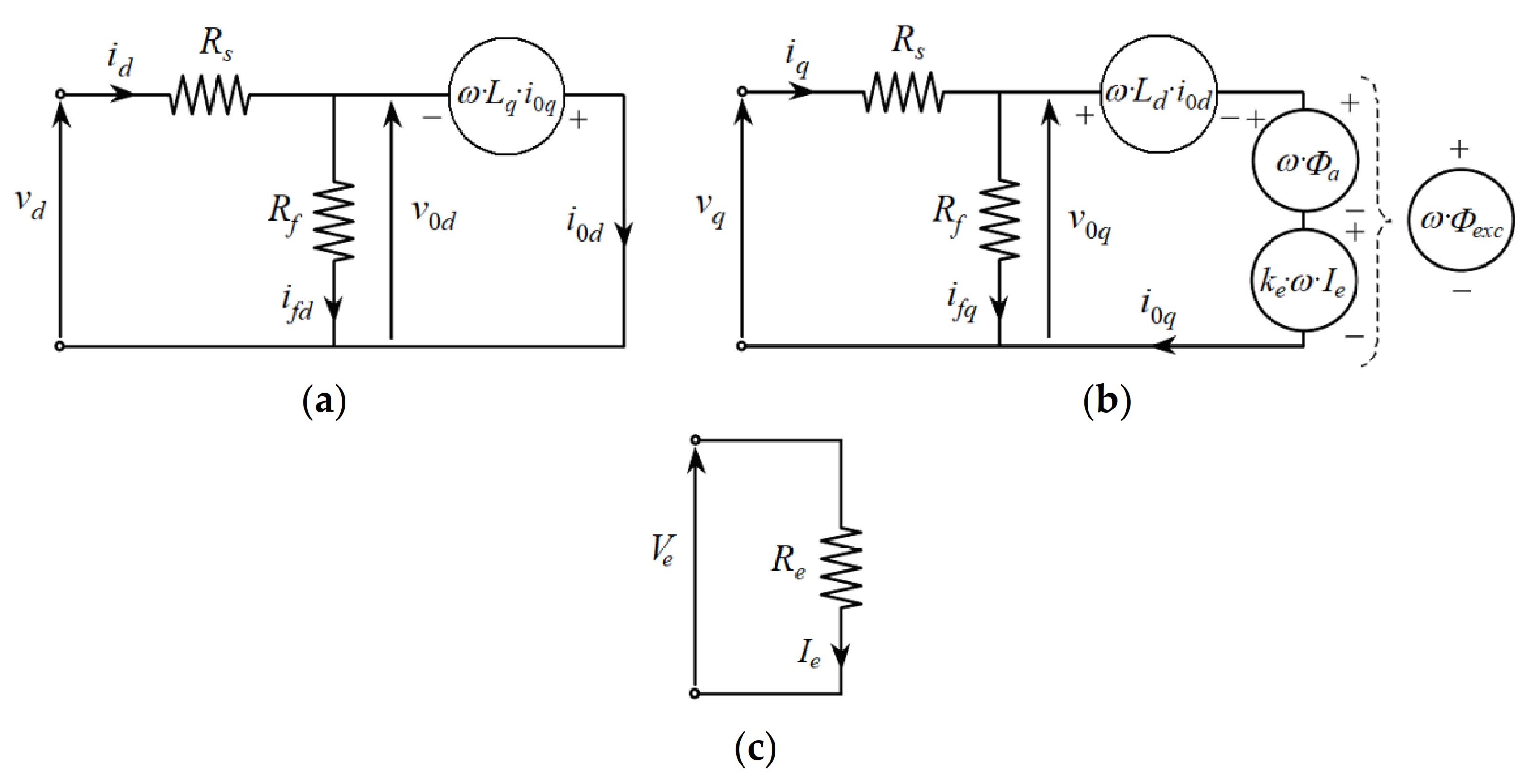


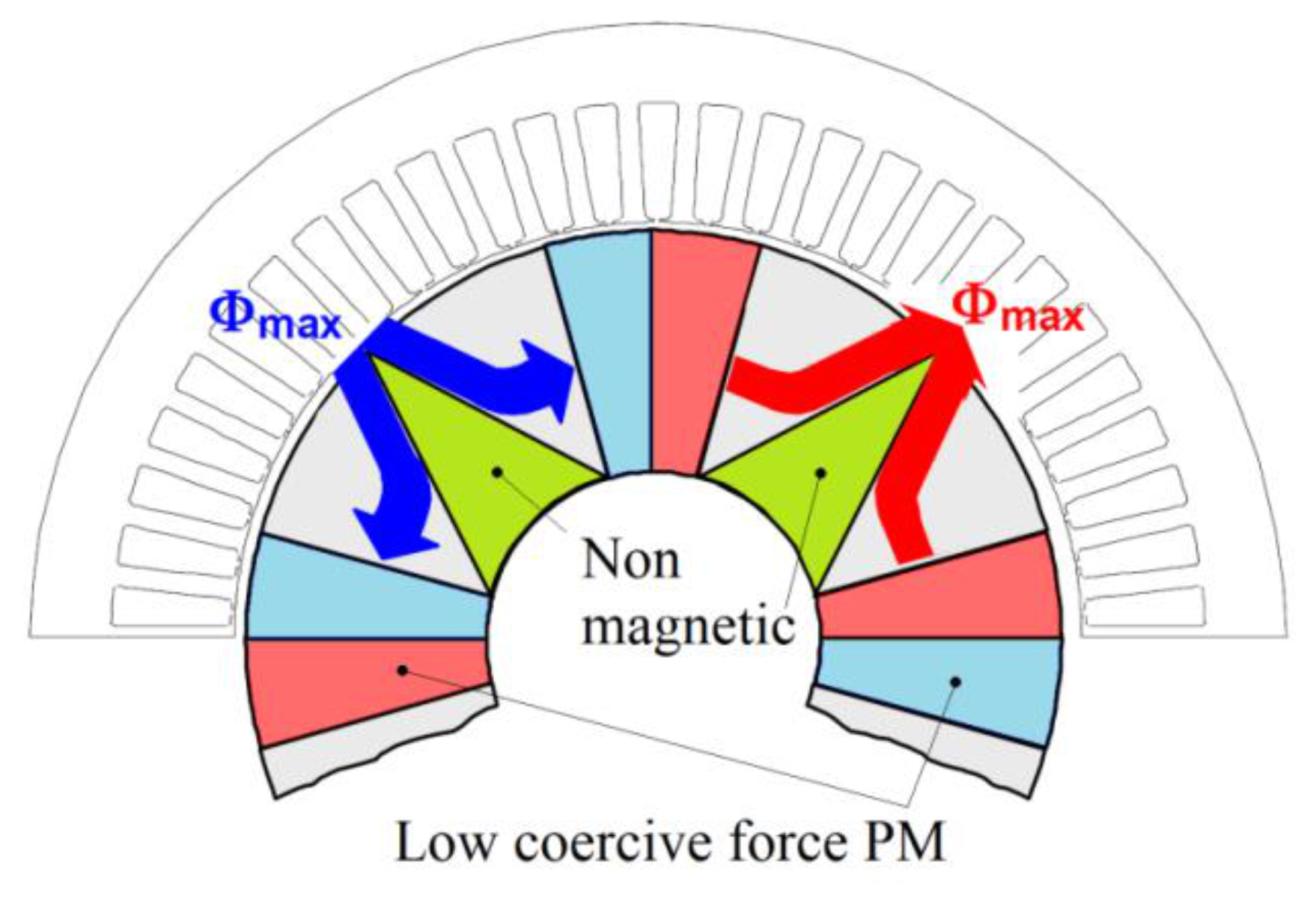
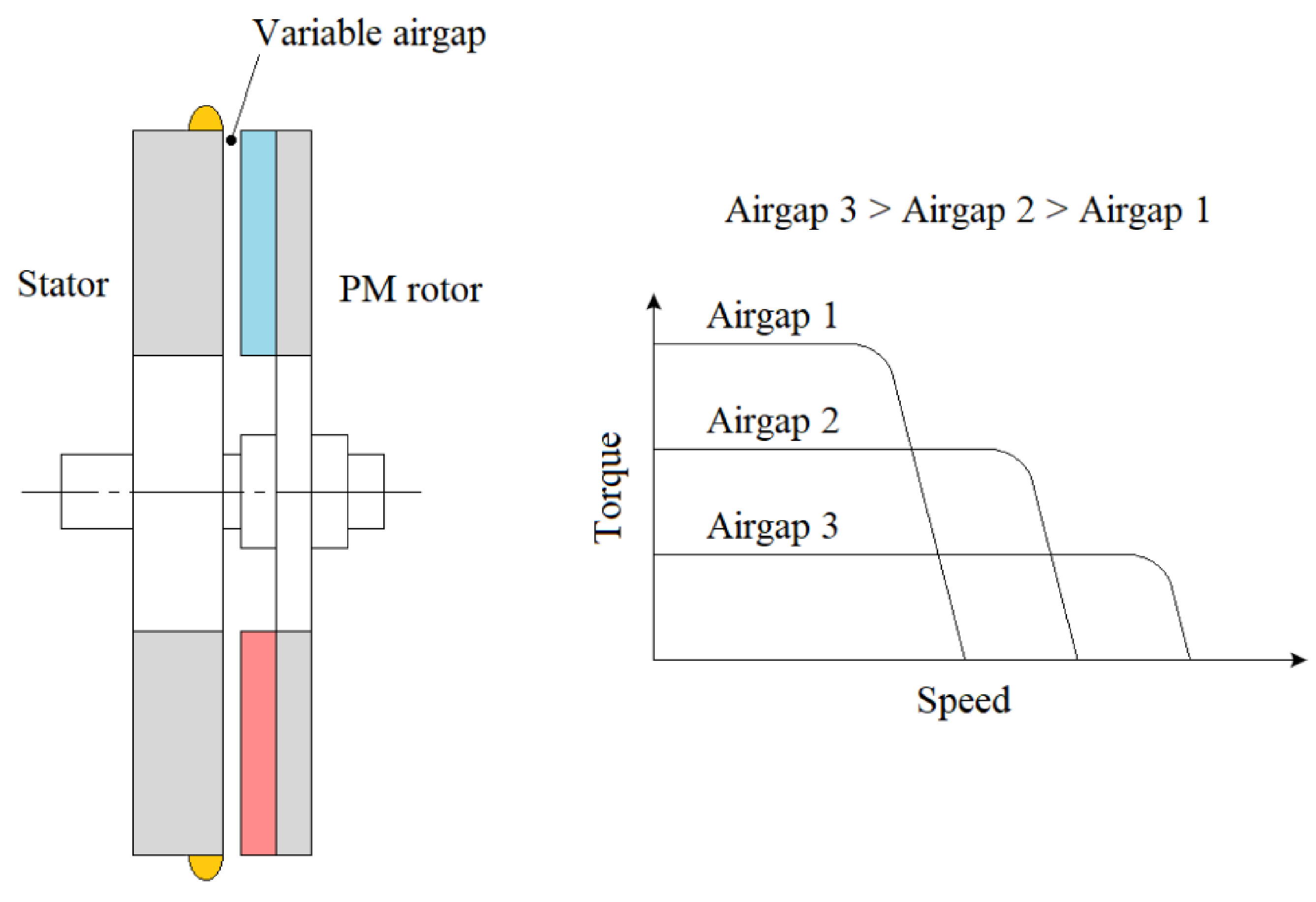
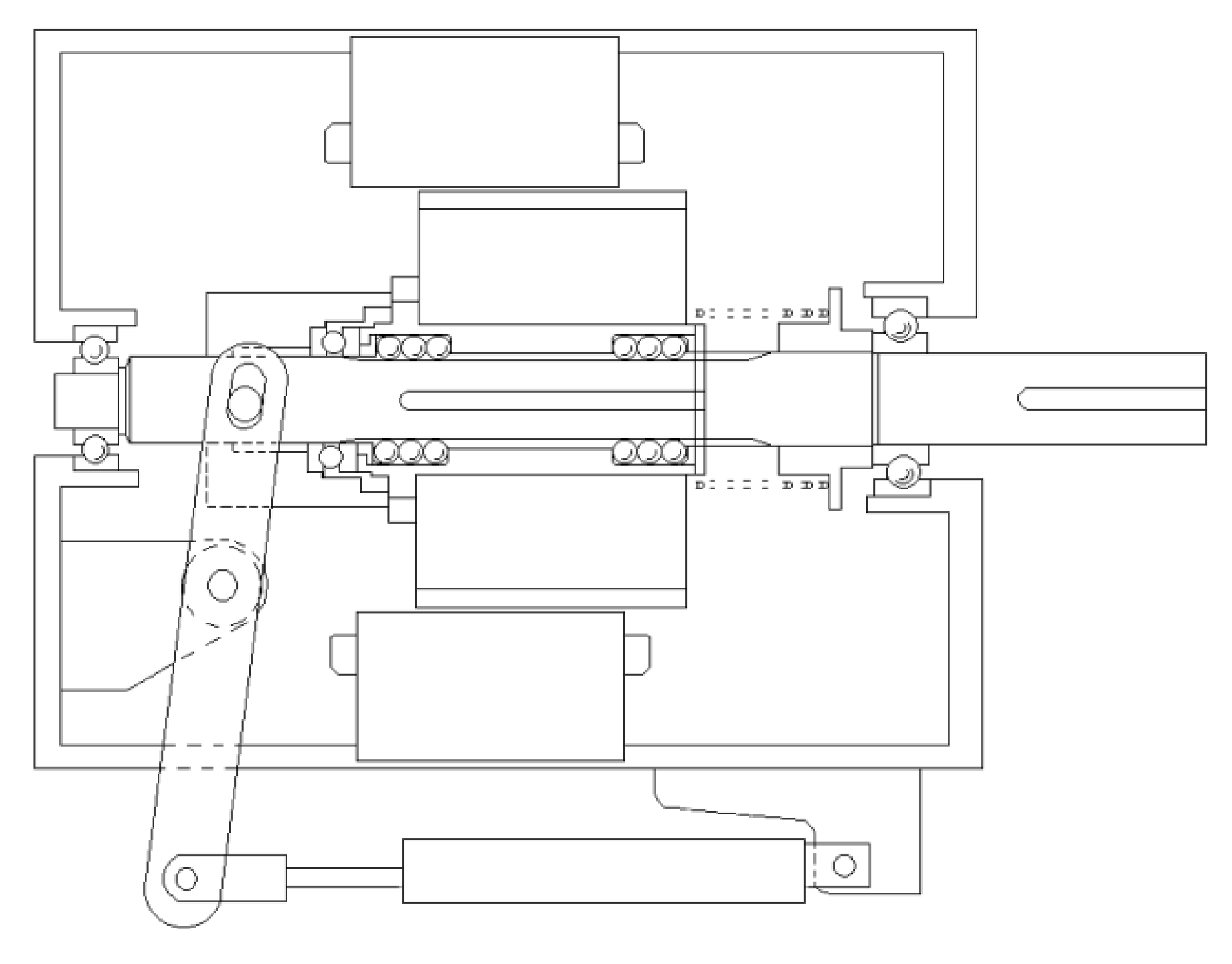



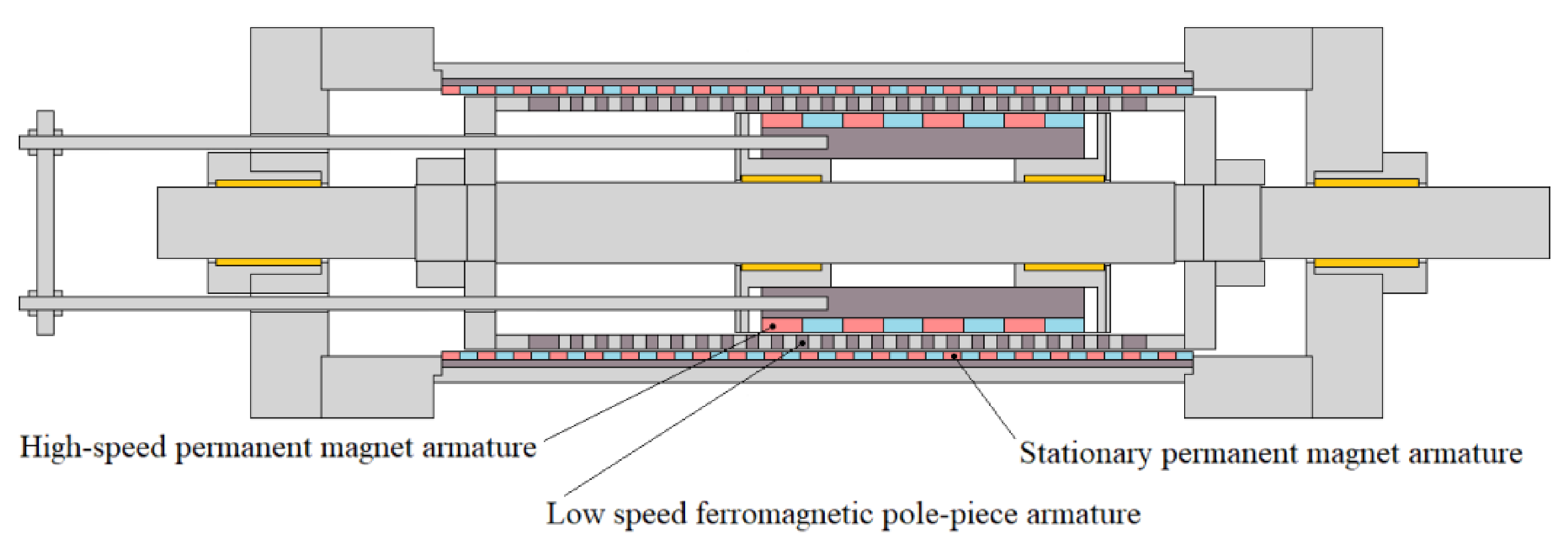
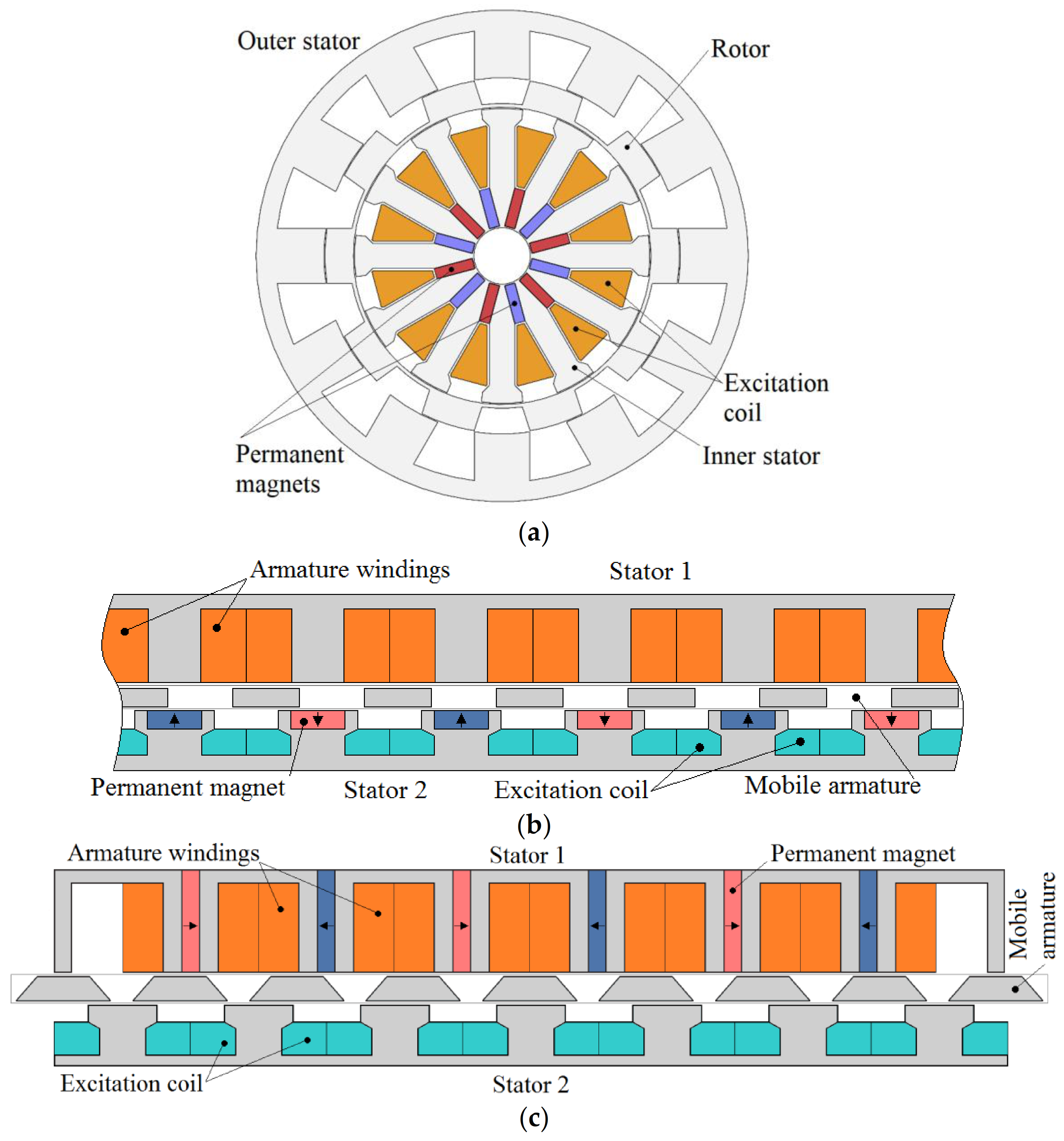
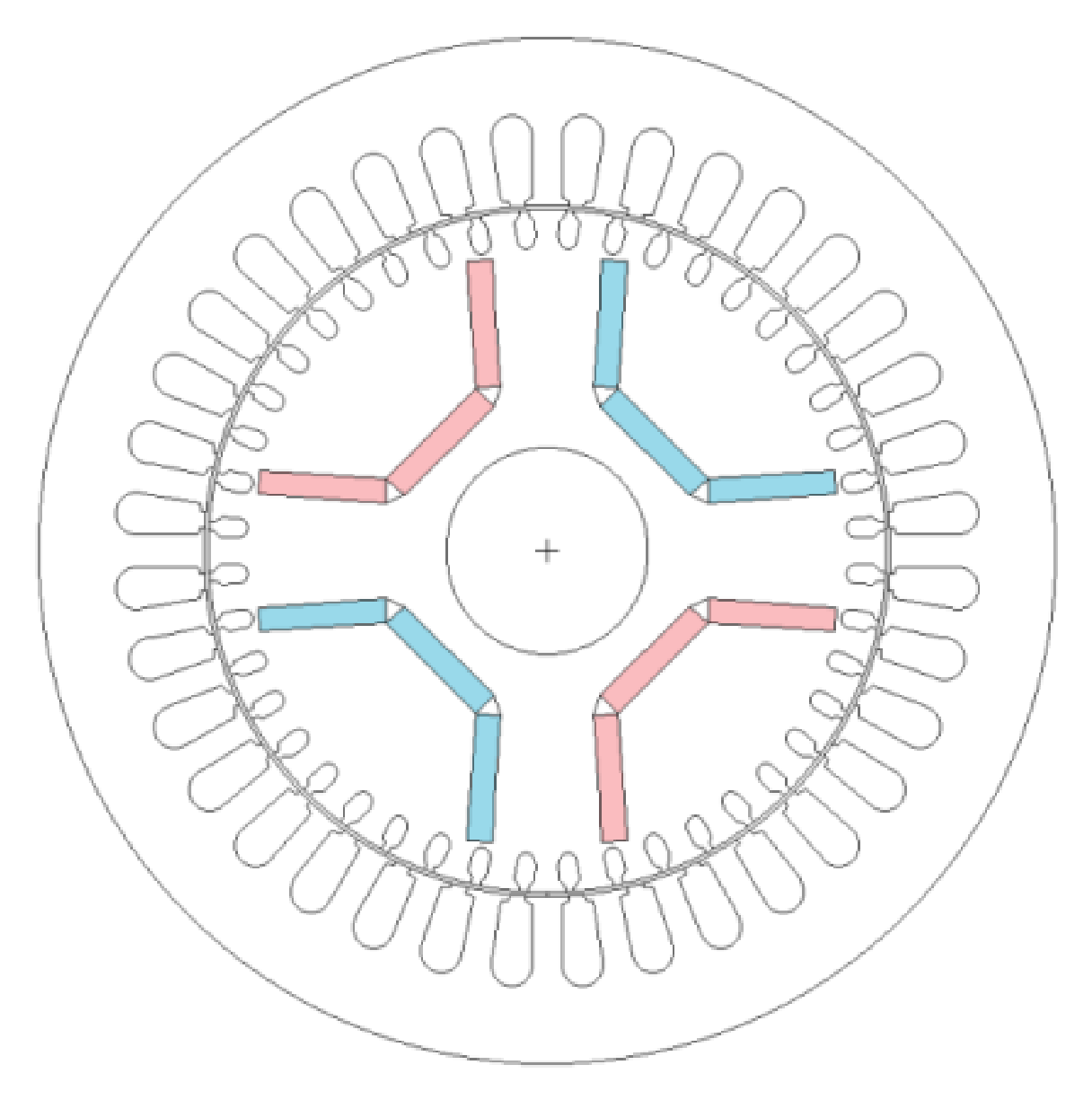
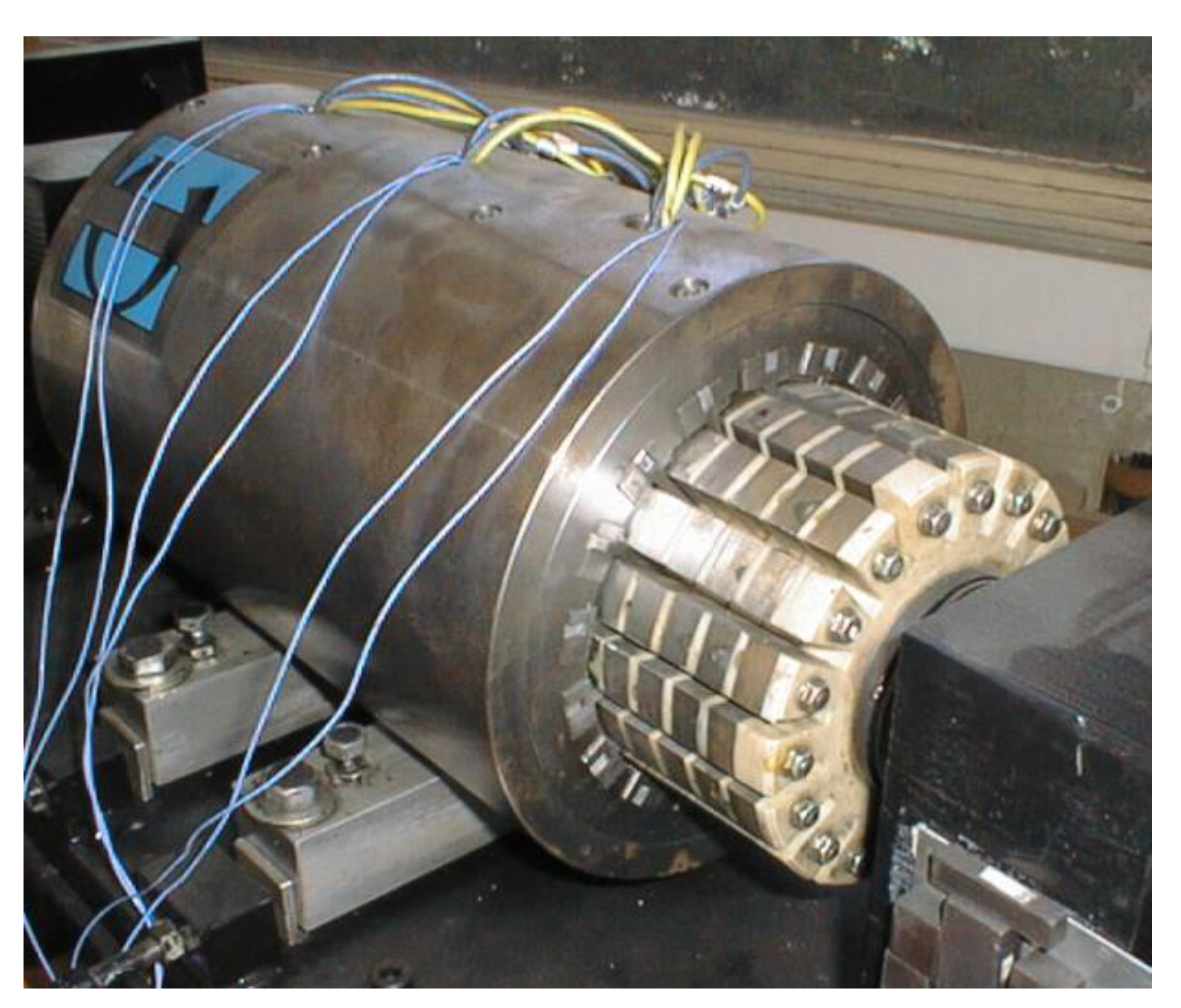
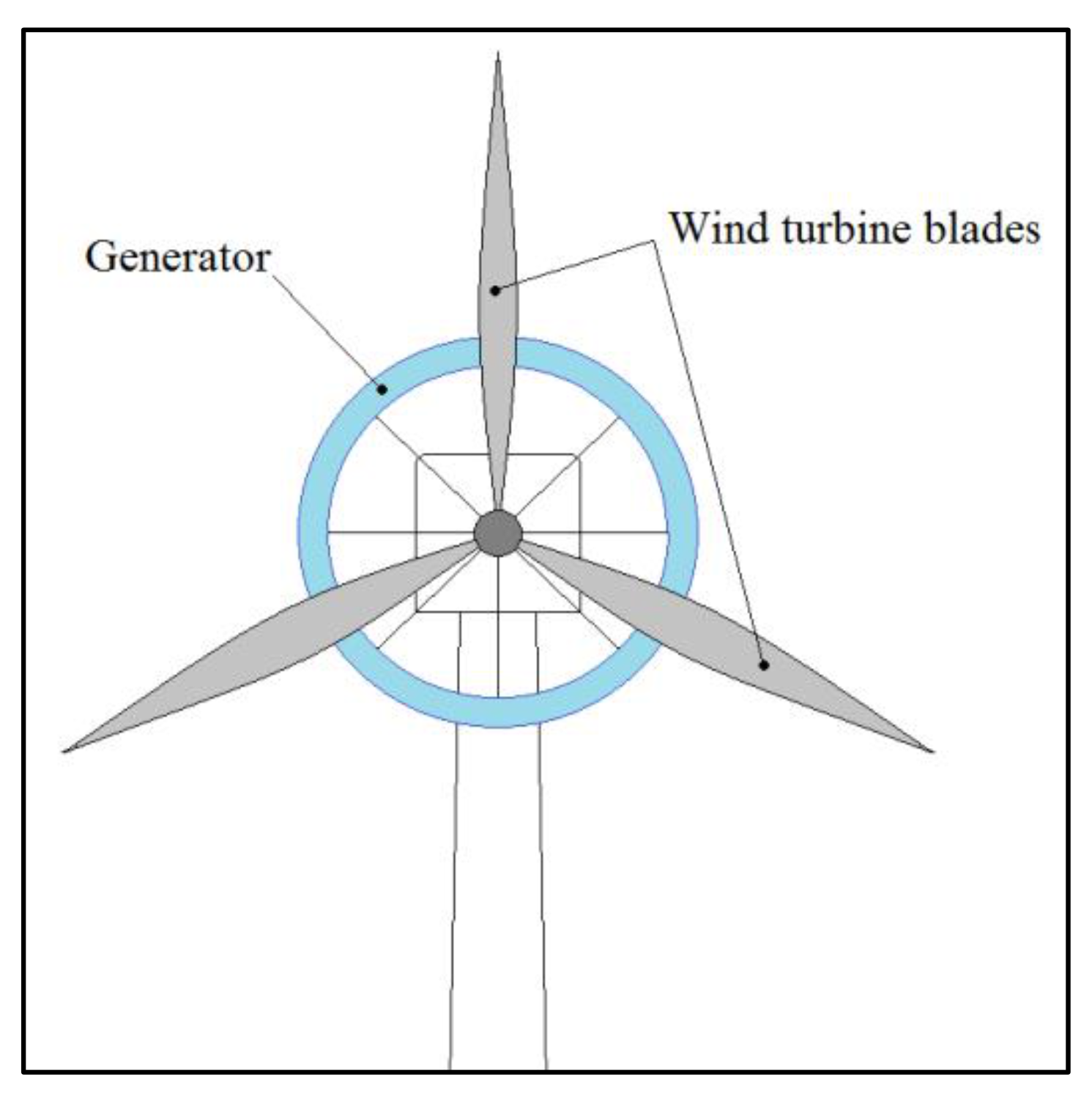


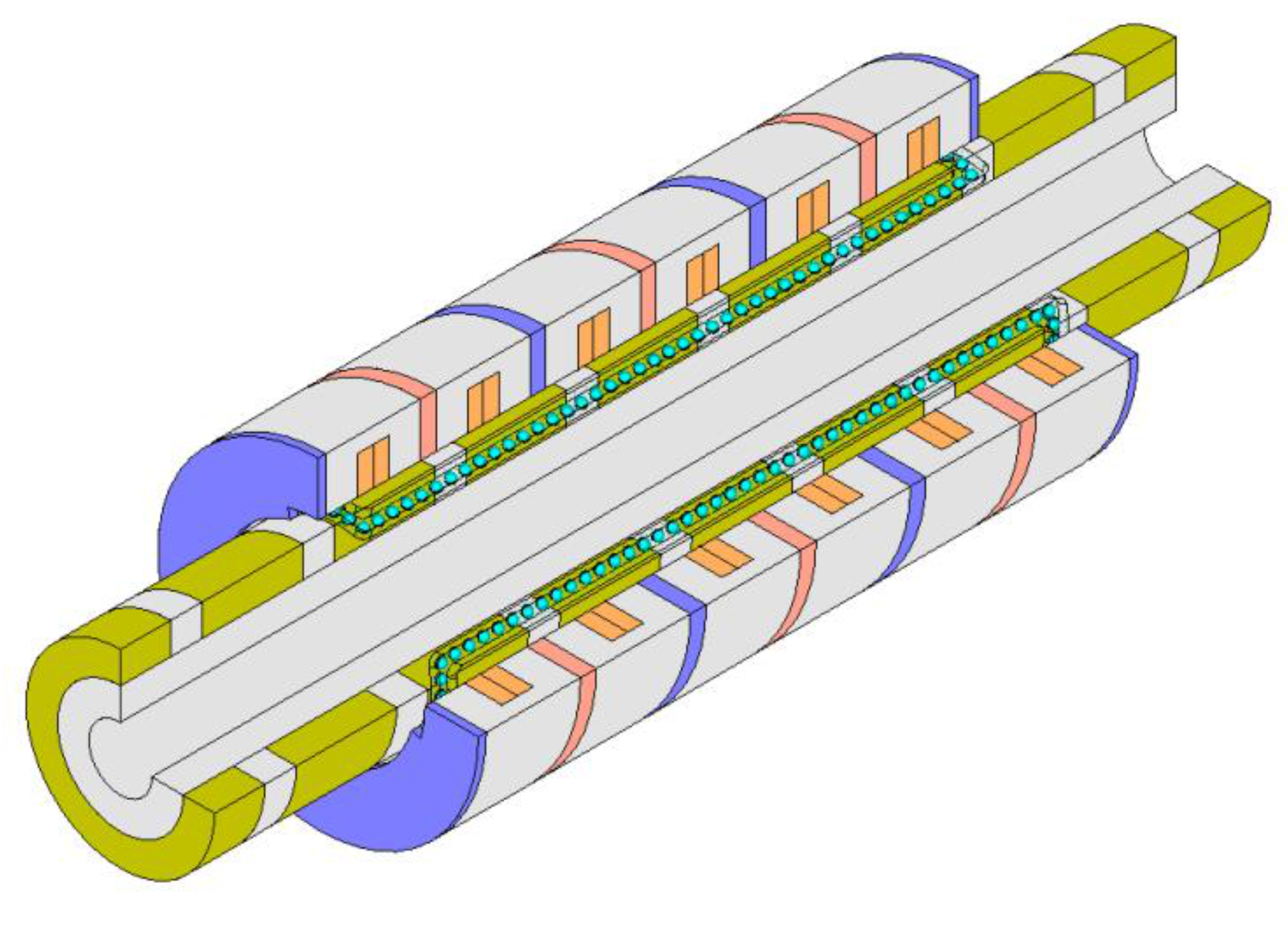
Publisher’s Note: MDPI stays neutral with regard to jurisdictional claims in published maps and institutional affiliations. |
© 2021 by the authors. Licensee MDPI, Basel, Switzerland. This article is an open access article distributed under the terms and conditions of the Creative Commons Attribution (CC BY) license (https://creativecommons.org/licenses/by/4.0/).
Share and Cite
Amara, Y.; Hlioui, S.; Gabsi, M. Overview of Degrees of Freedom in the Design of PM Synchronous Machines. Energies 2021, 14, 3990. https://doi.org/10.3390/en14133990
Amara Y, Hlioui S, Gabsi M. Overview of Degrees of Freedom in the Design of PM Synchronous Machines. Energies. 2021; 14(13):3990. https://doi.org/10.3390/en14133990
Chicago/Turabian StyleAmara, Yacine, Sami Hlioui, and Mohamed Gabsi. 2021. "Overview of Degrees of Freedom in the Design of PM Synchronous Machines" Energies 14, no. 13: 3990. https://doi.org/10.3390/en14133990
APA StyleAmara, Y., Hlioui, S., & Gabsi, M. (2021). Overview of Degrees of Freedom in the Design of PM Synchronous Machines. Energies, 14(13), 3990. https://doi.org/10.3390/en14133990





